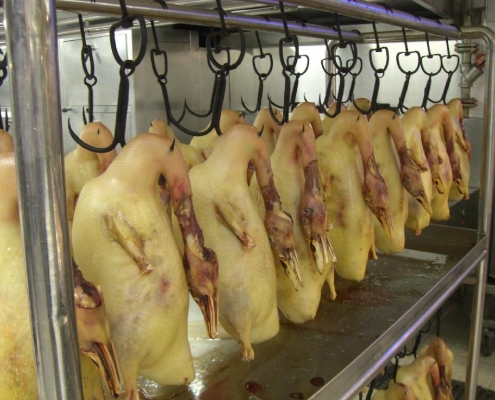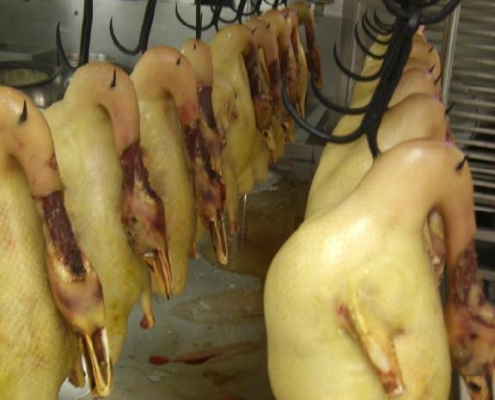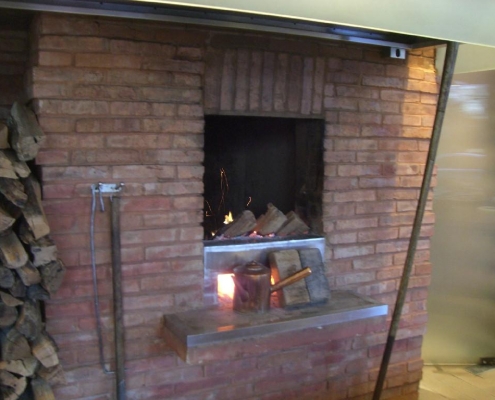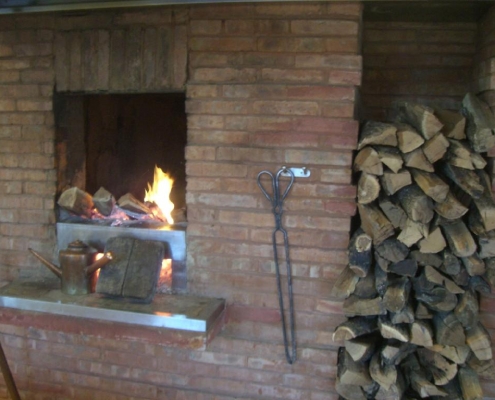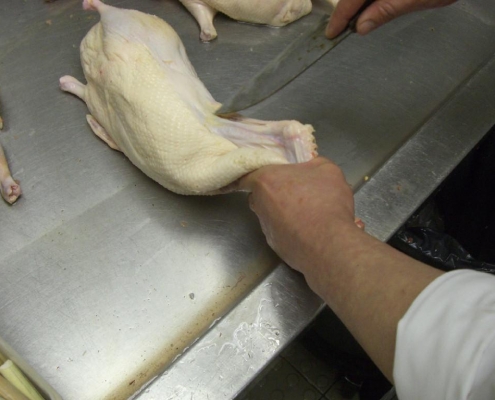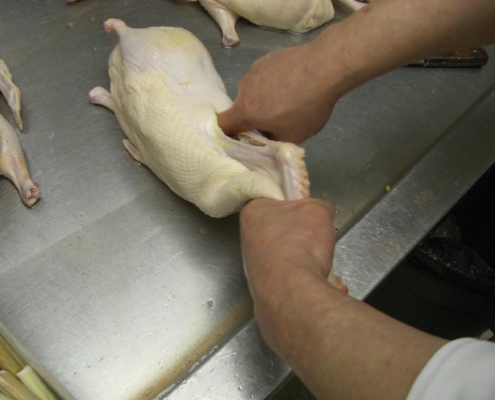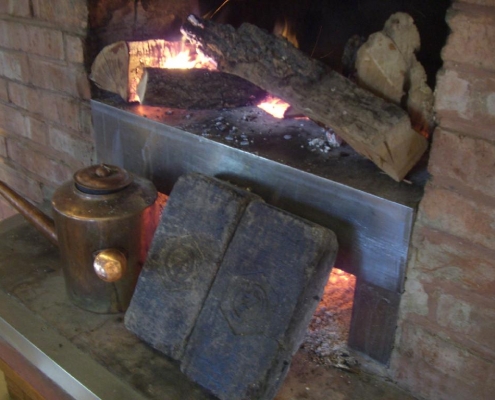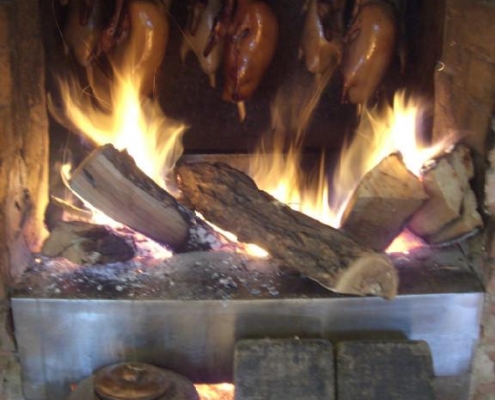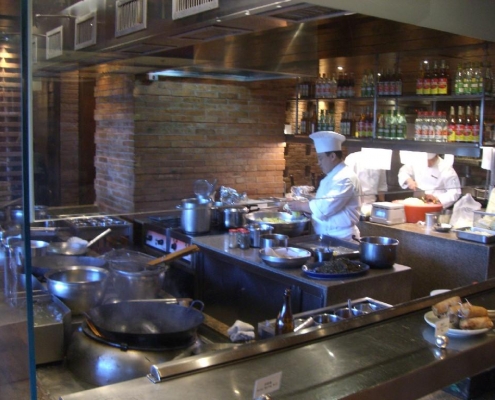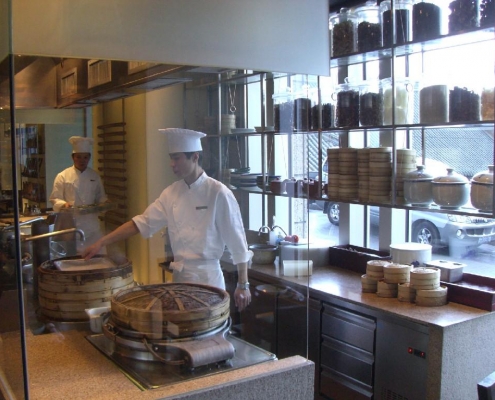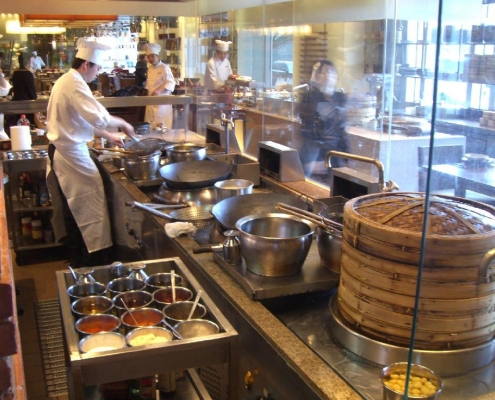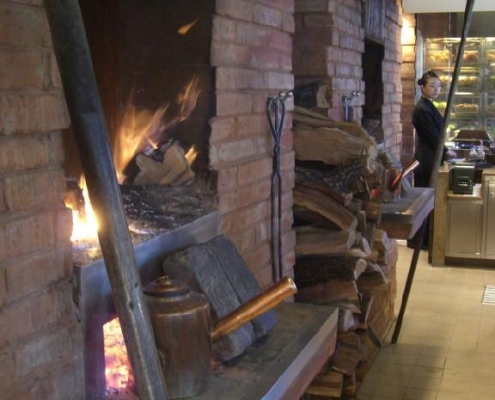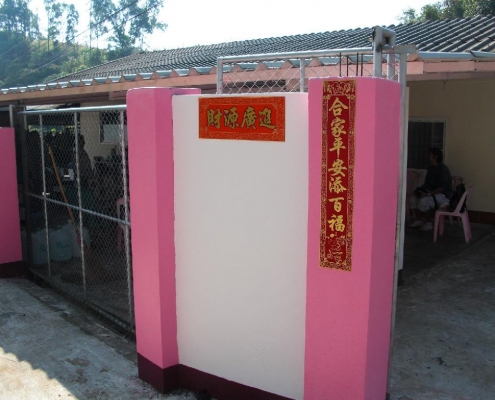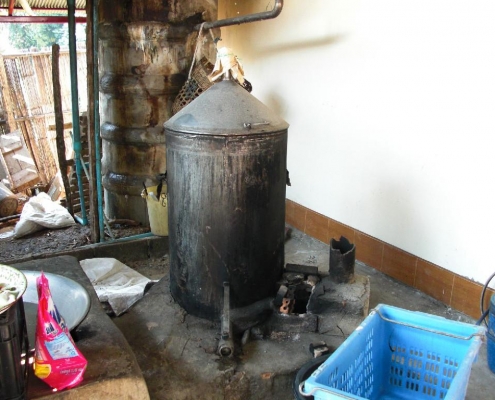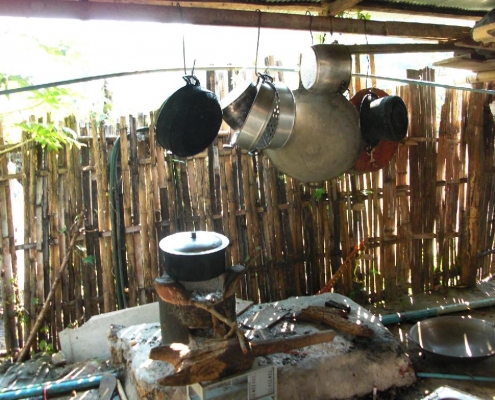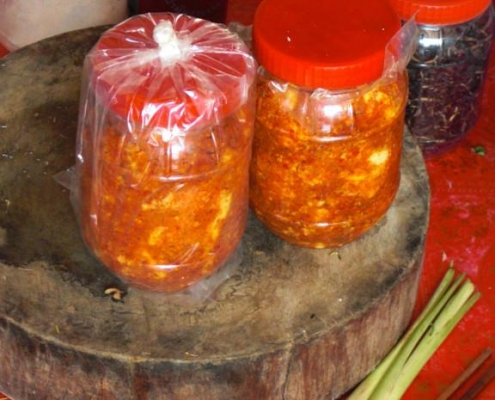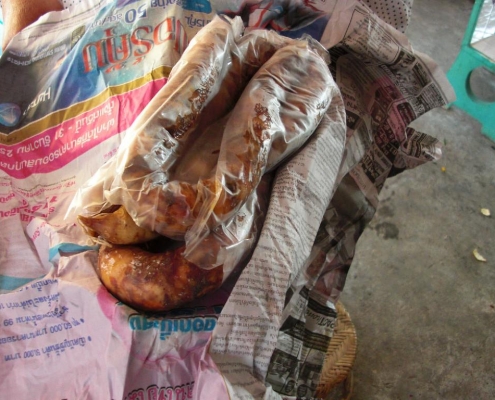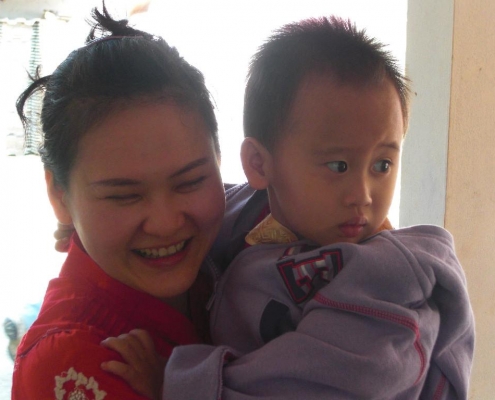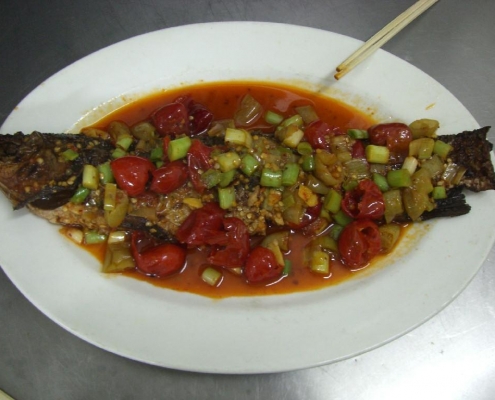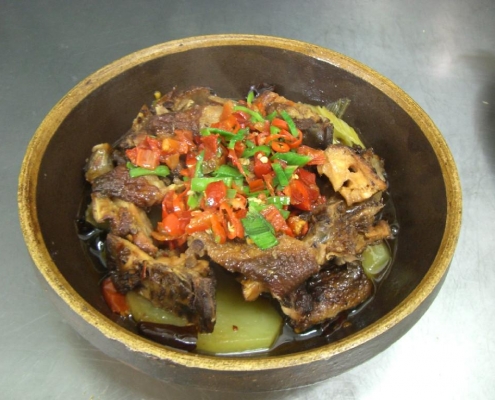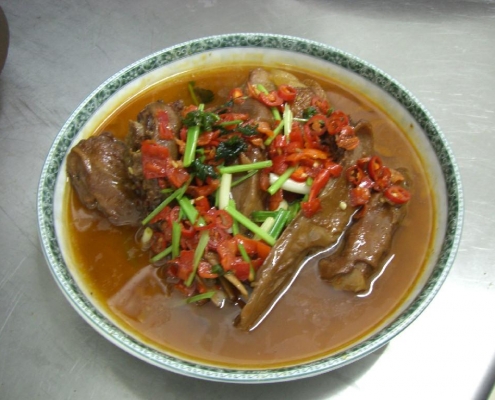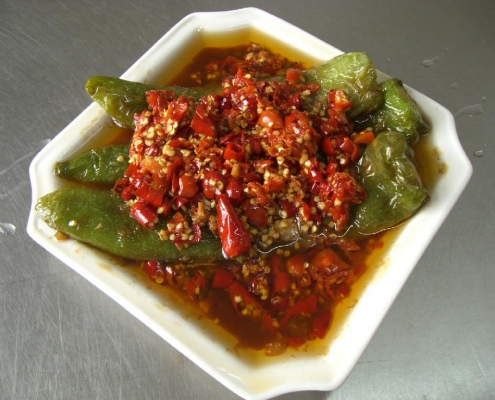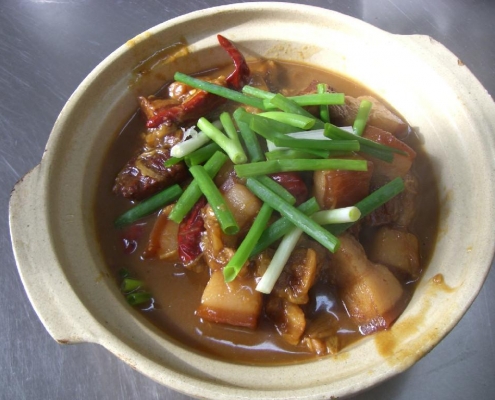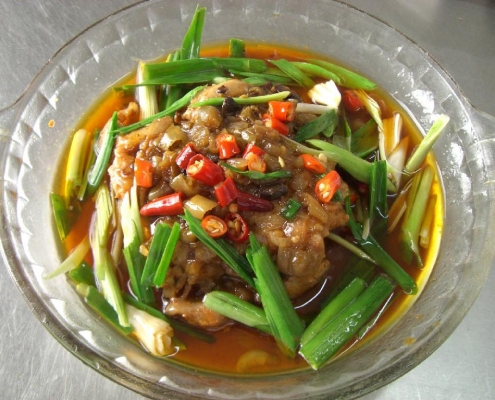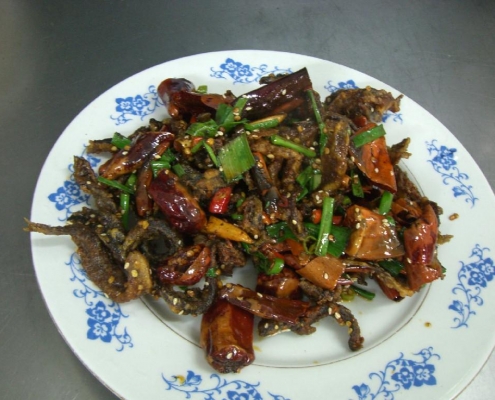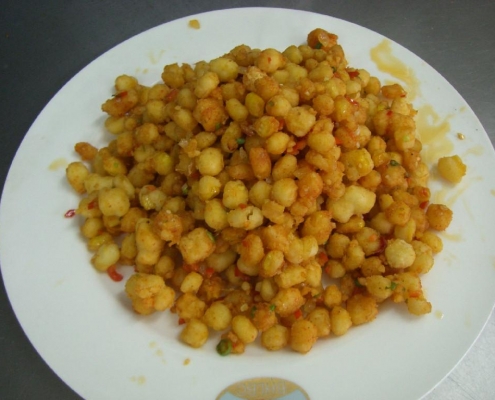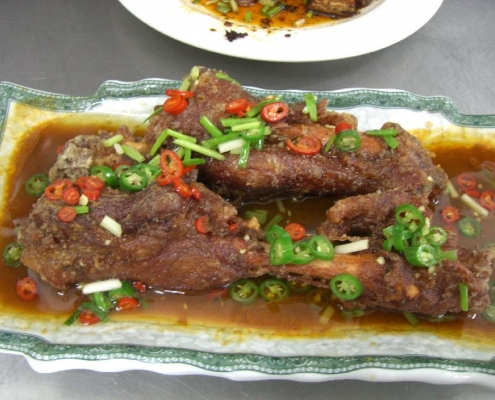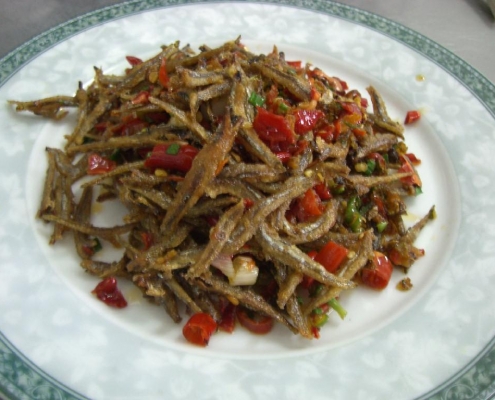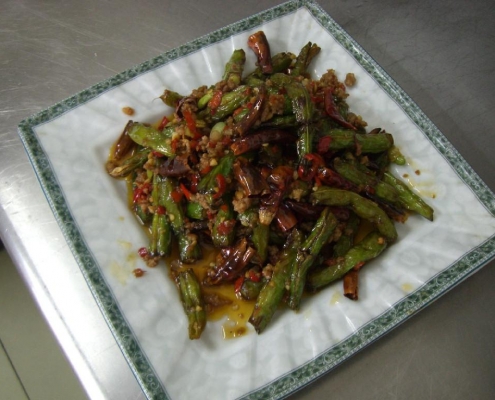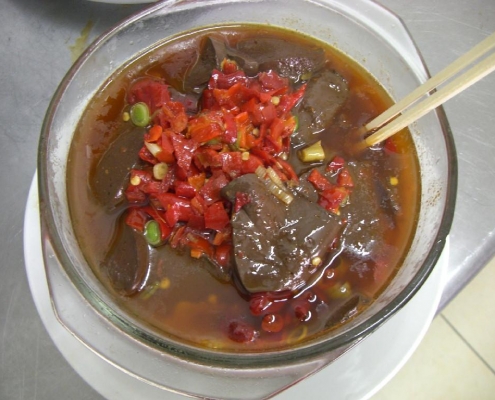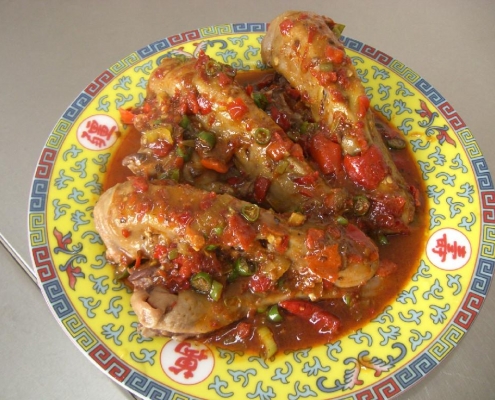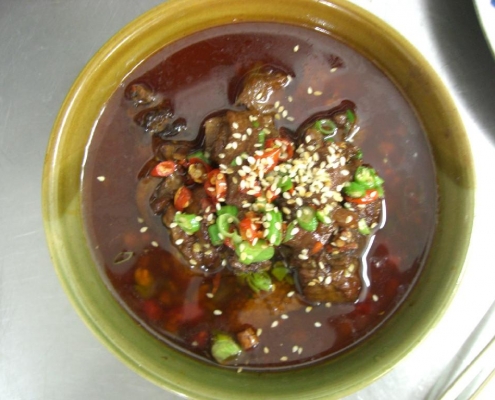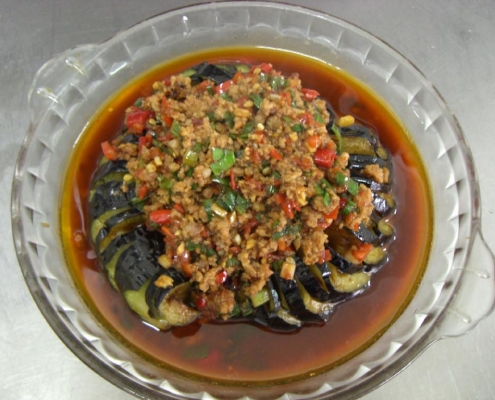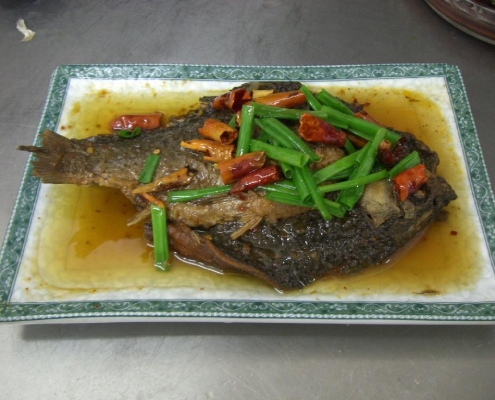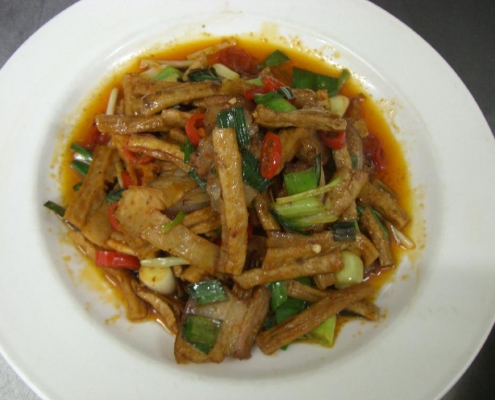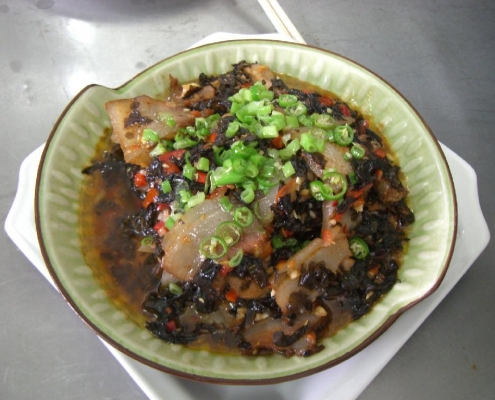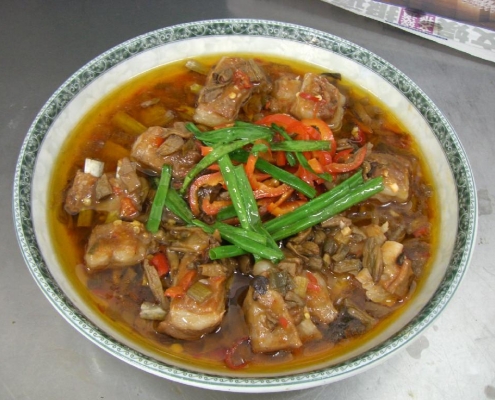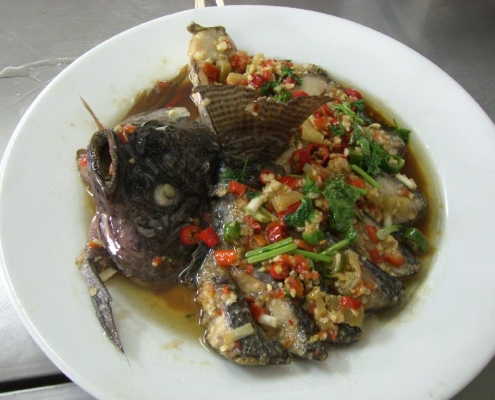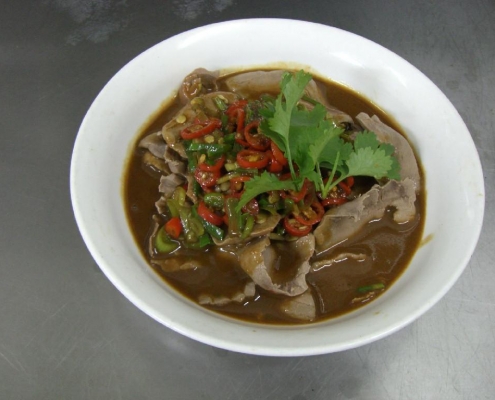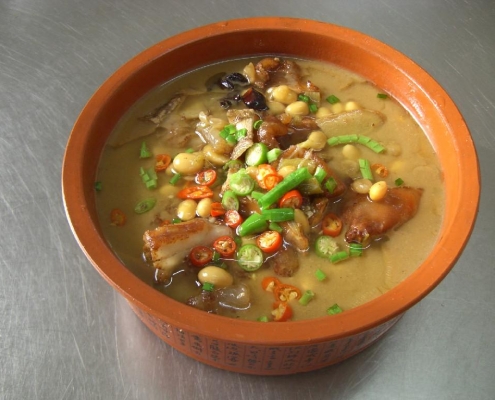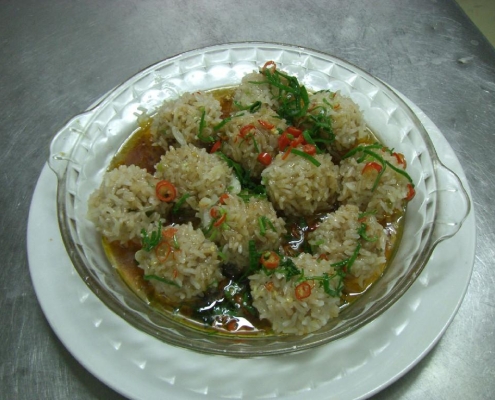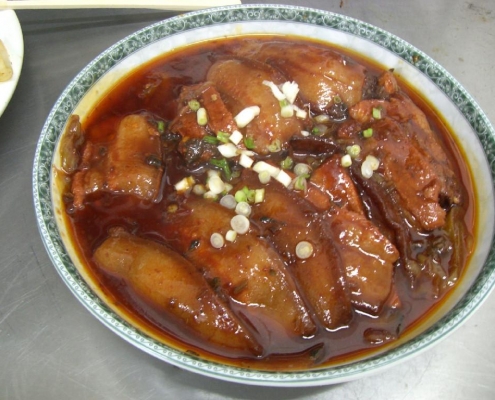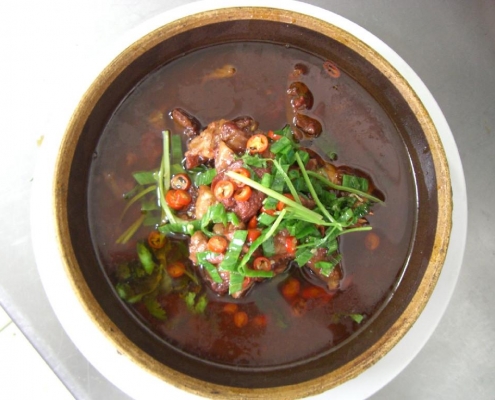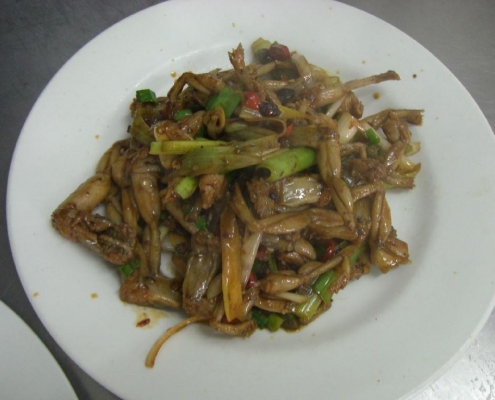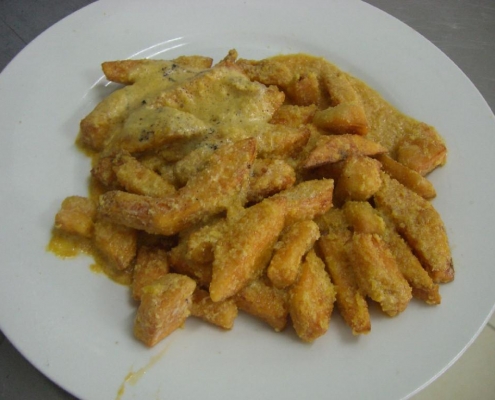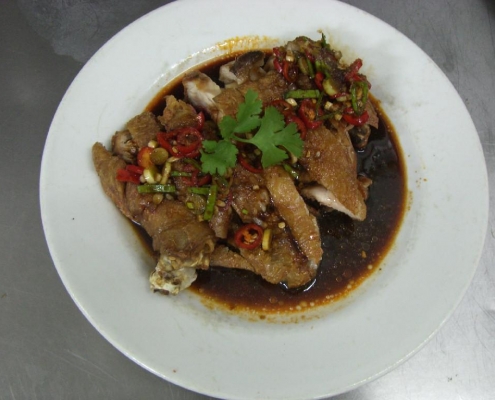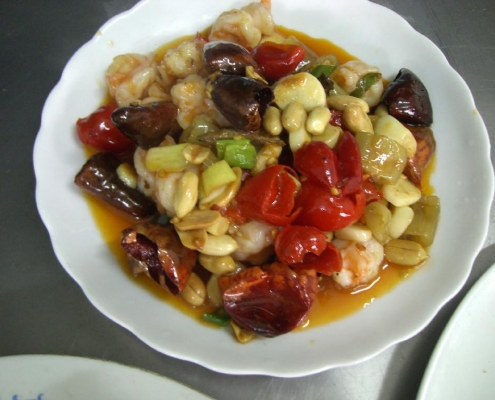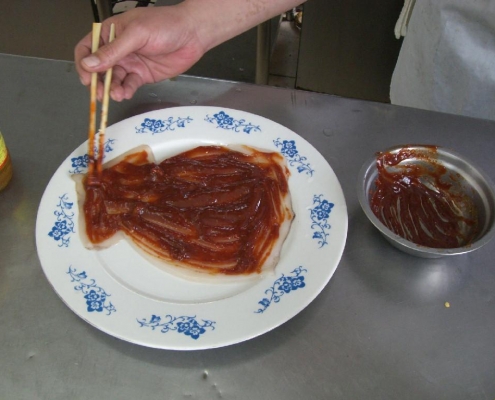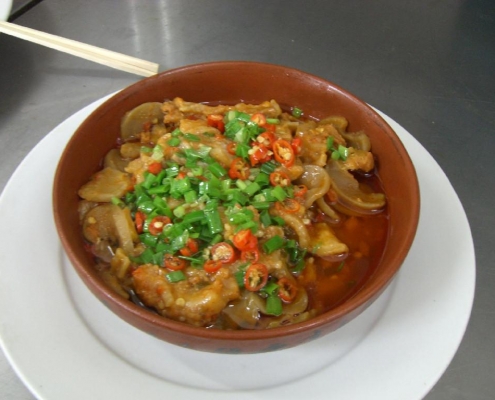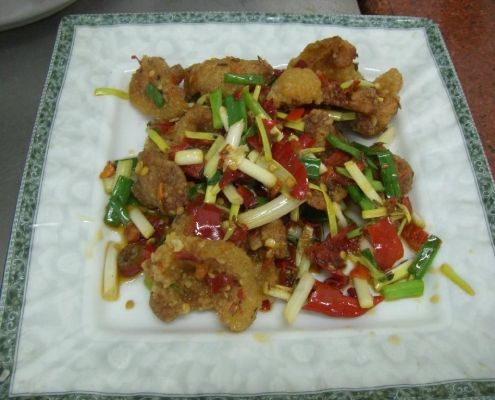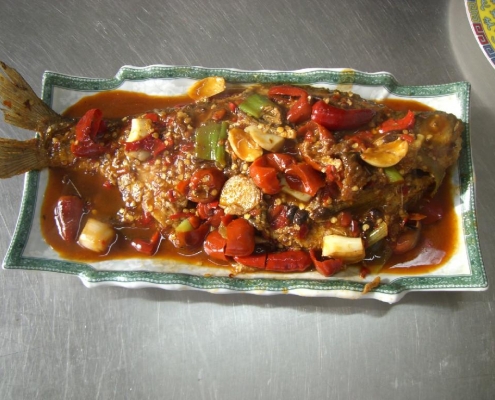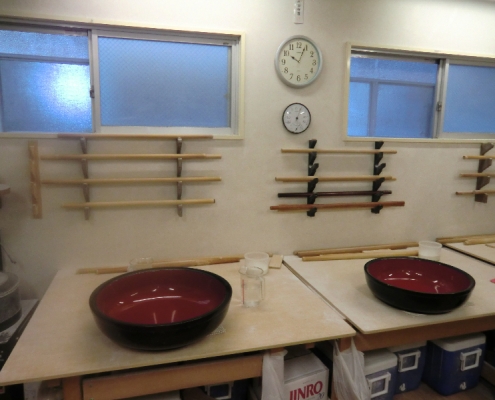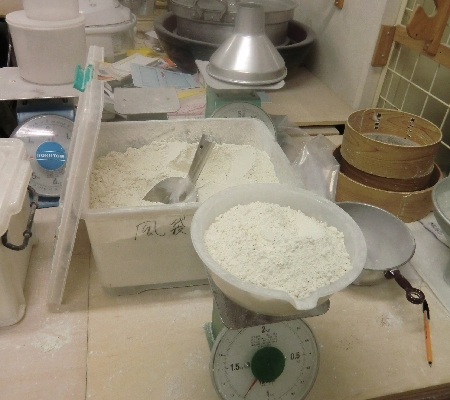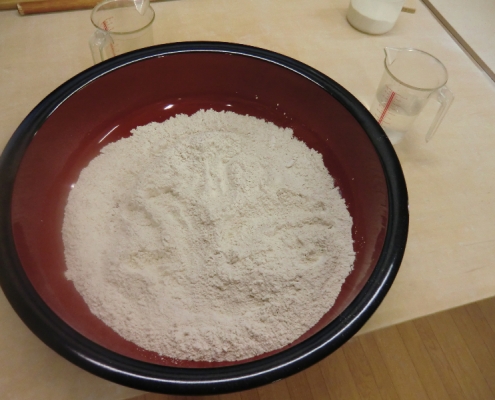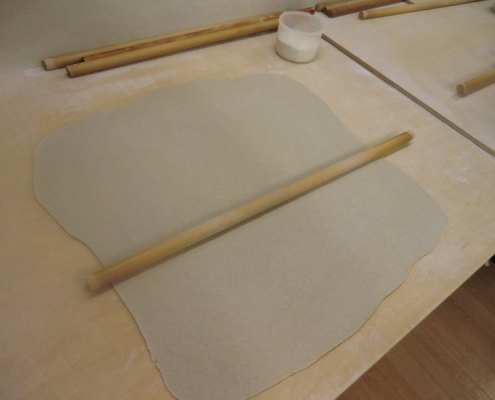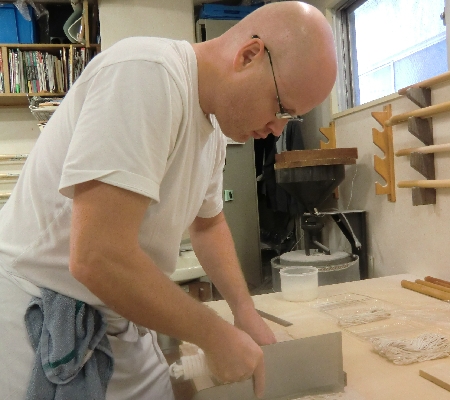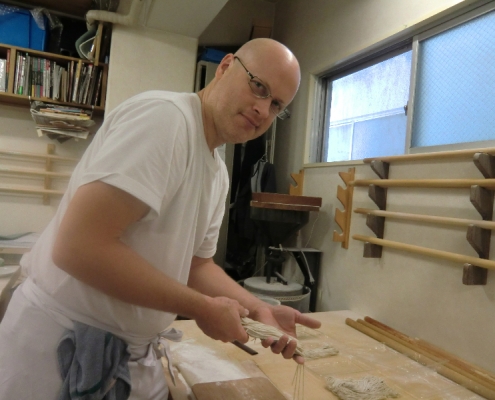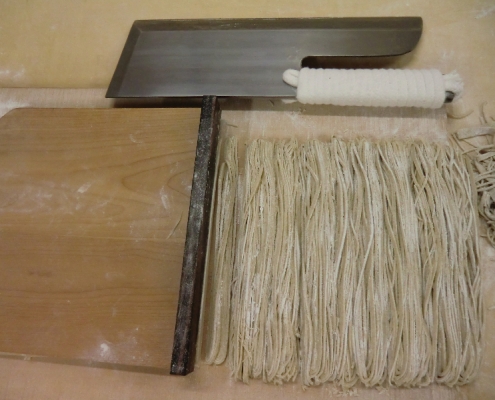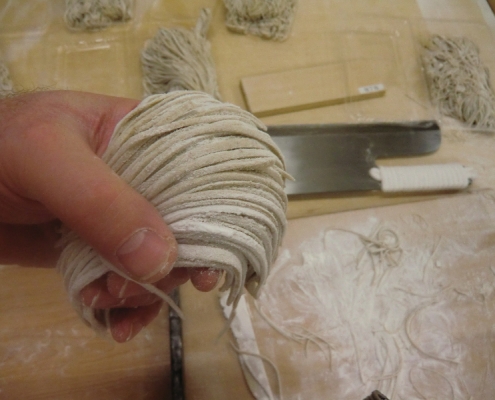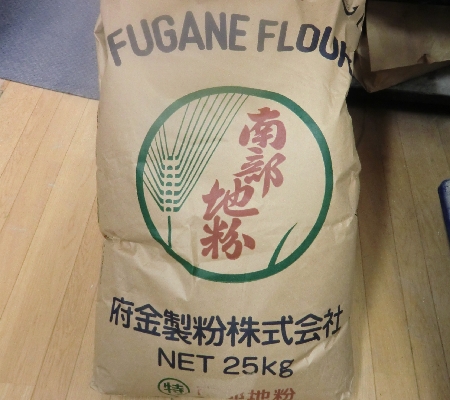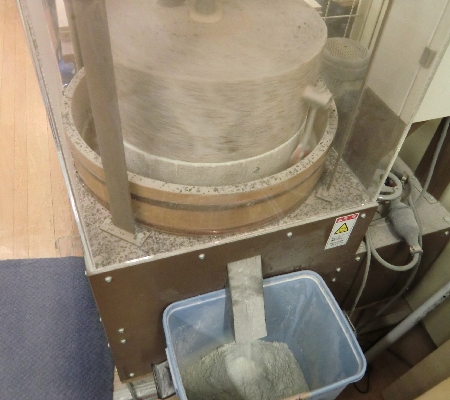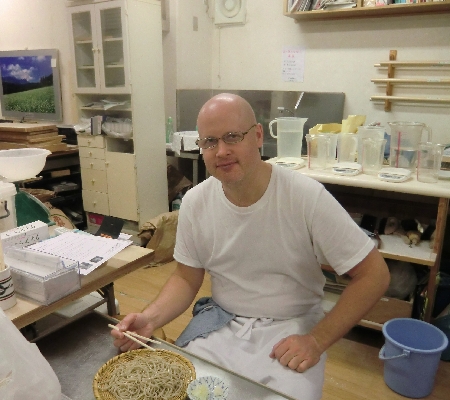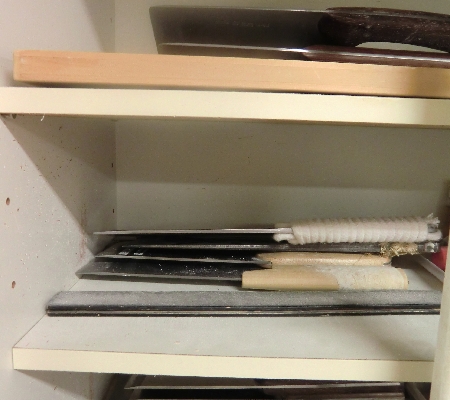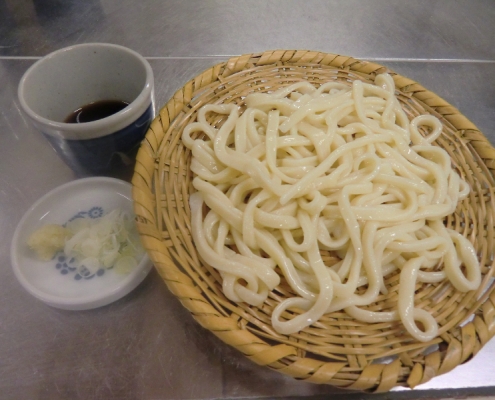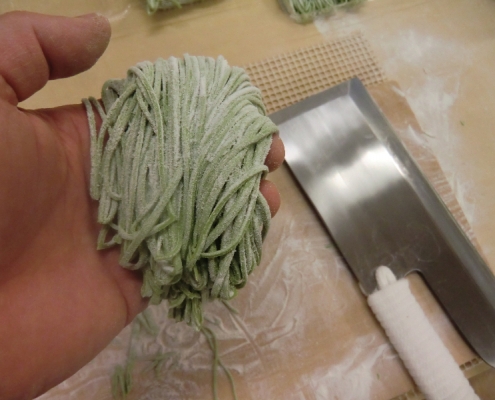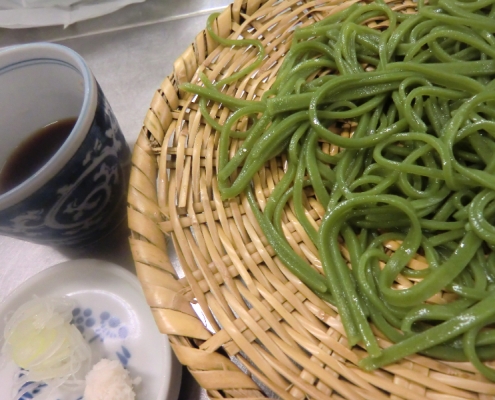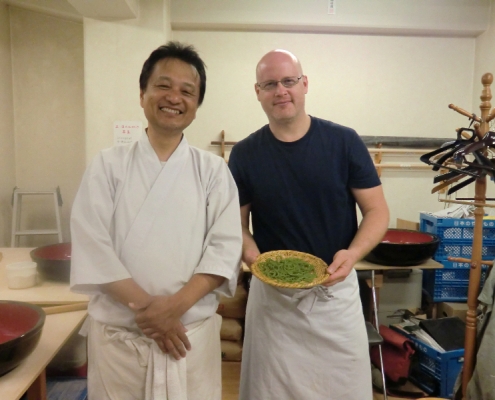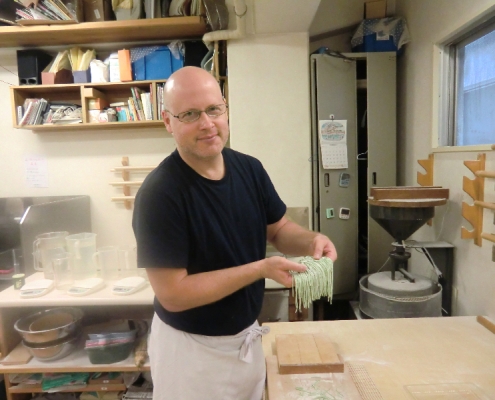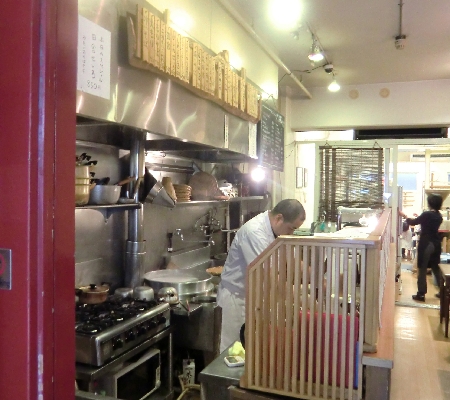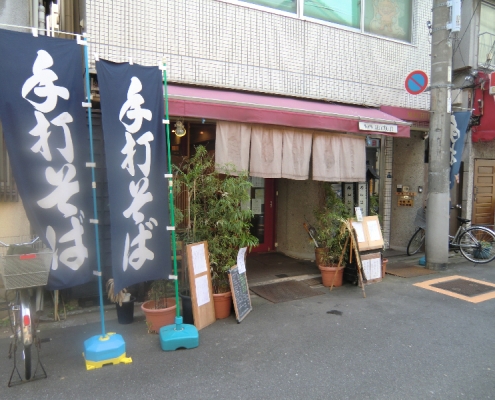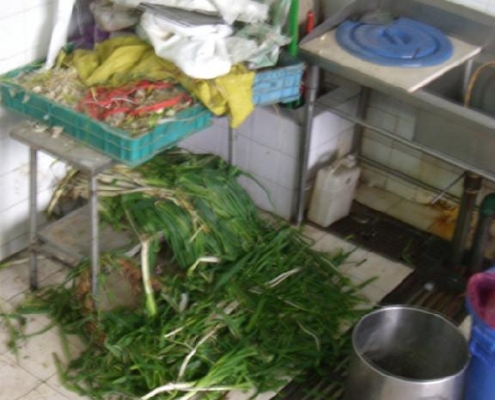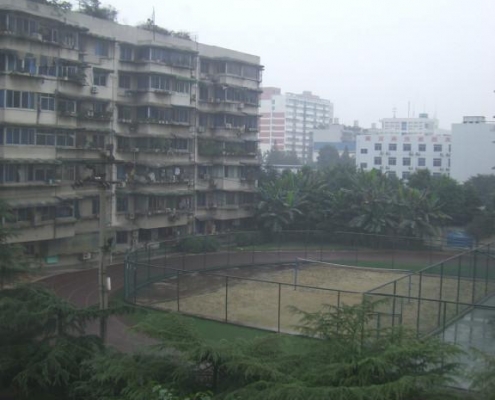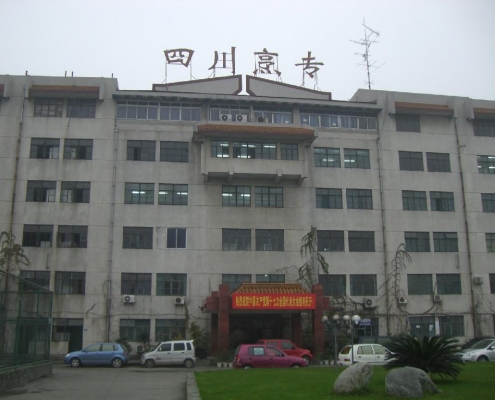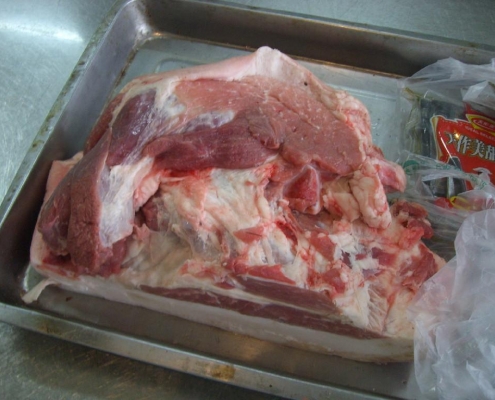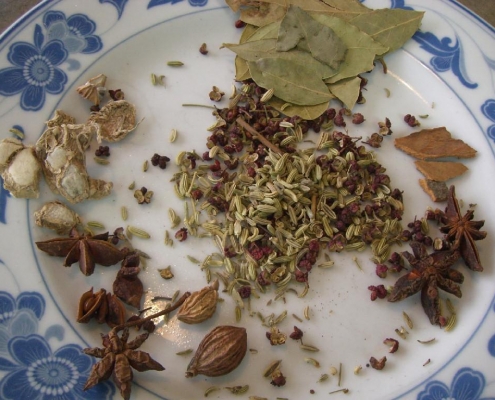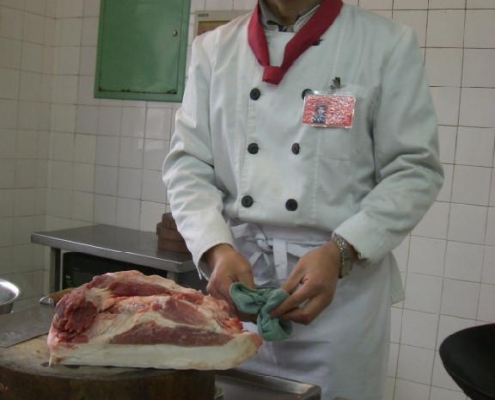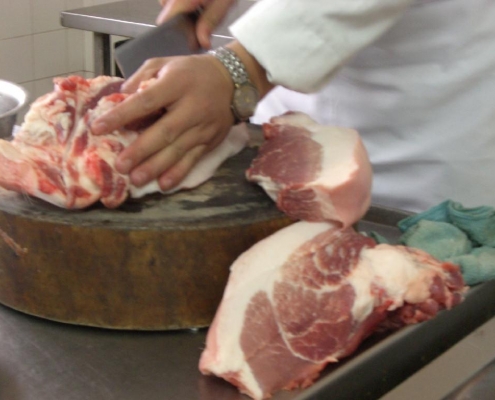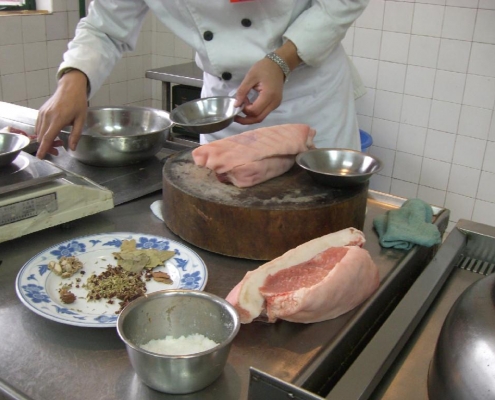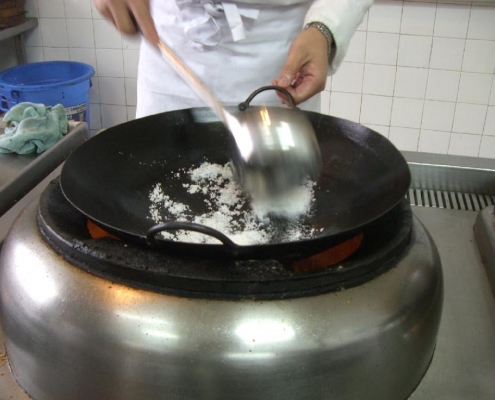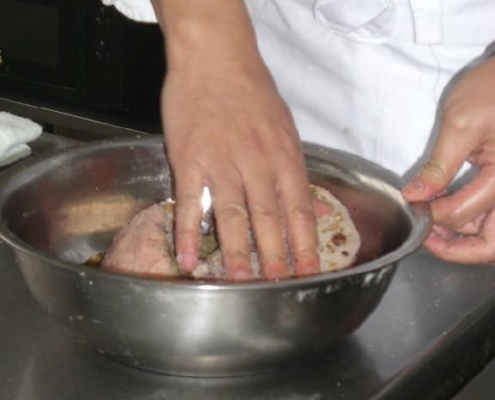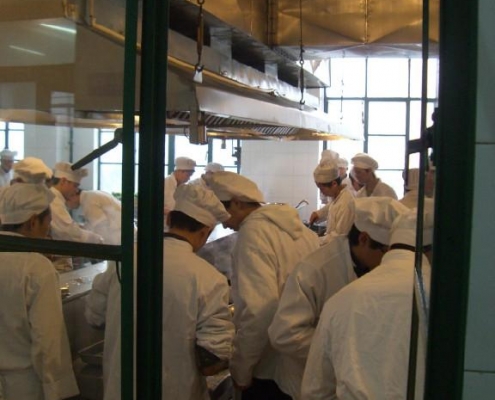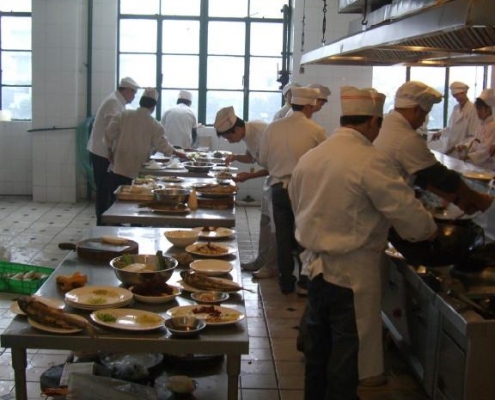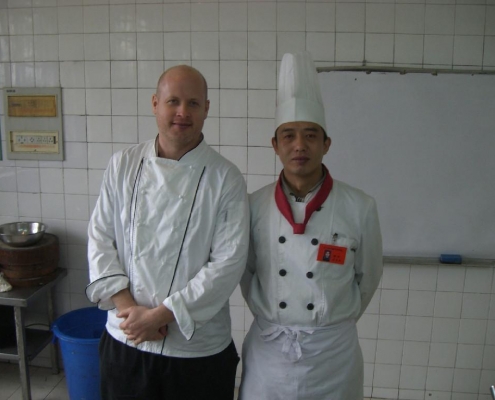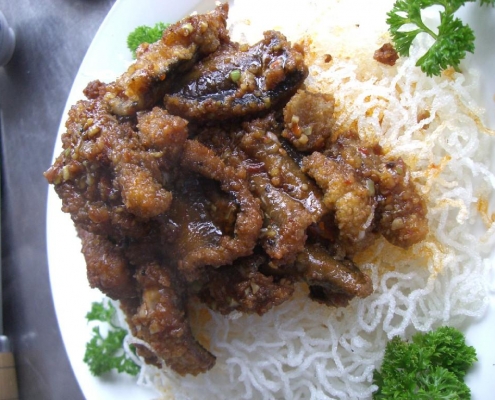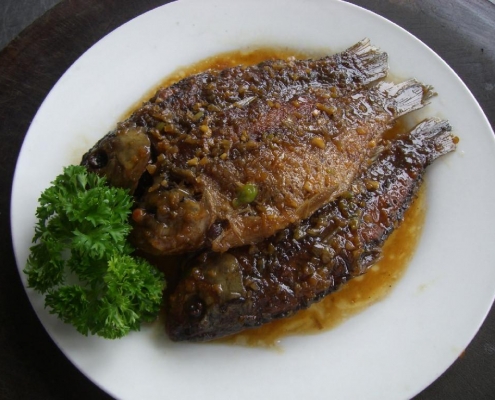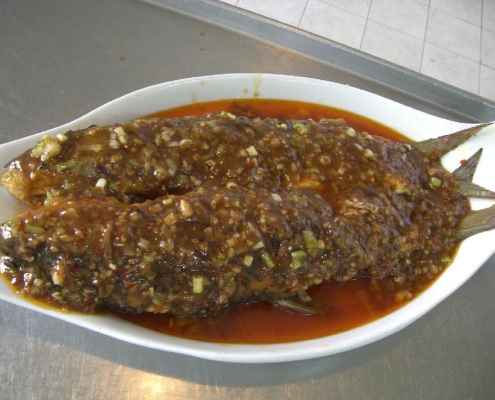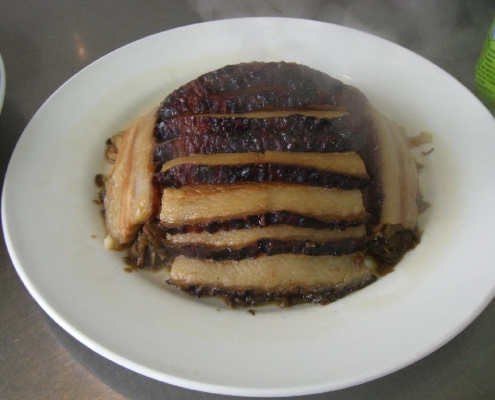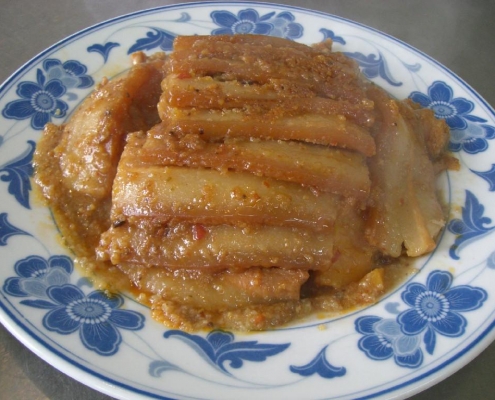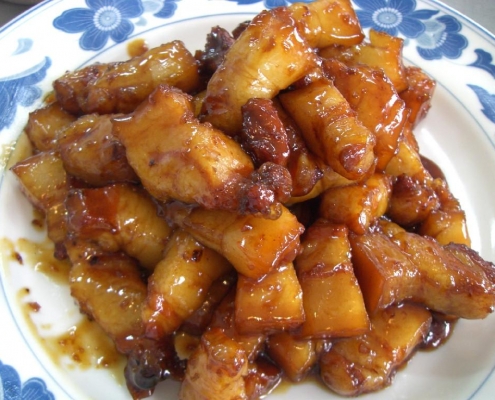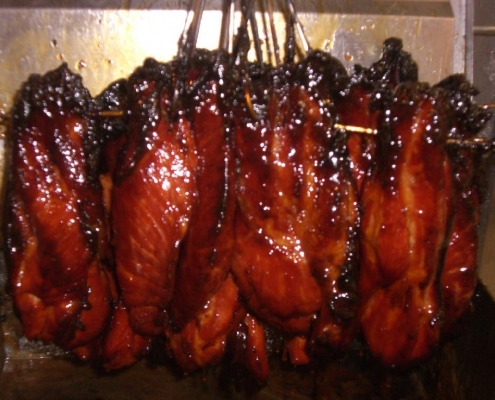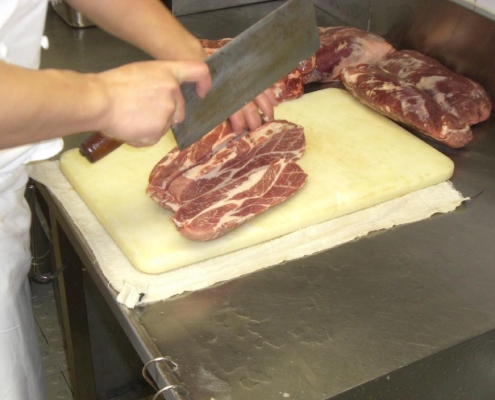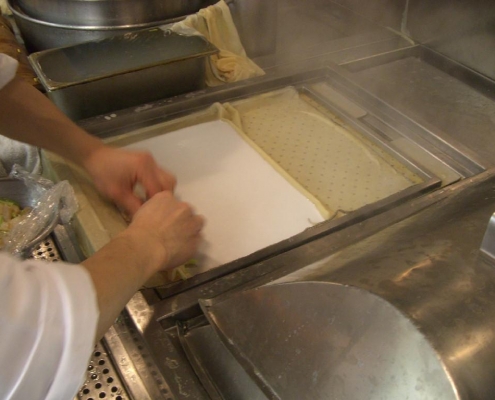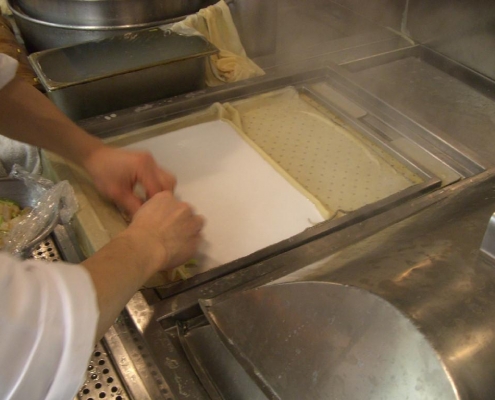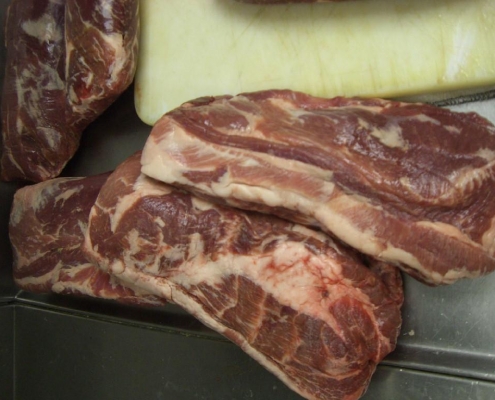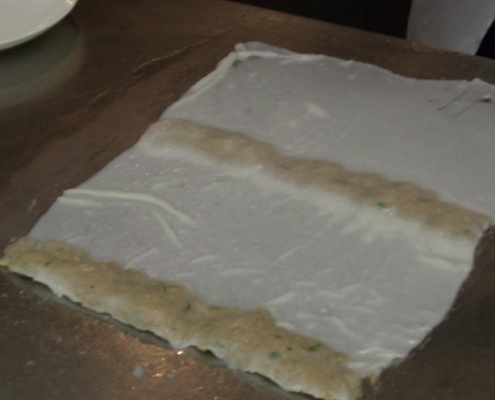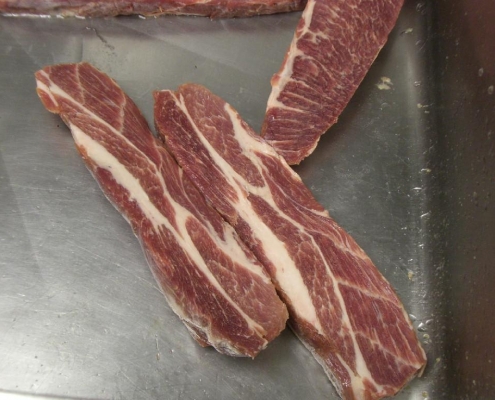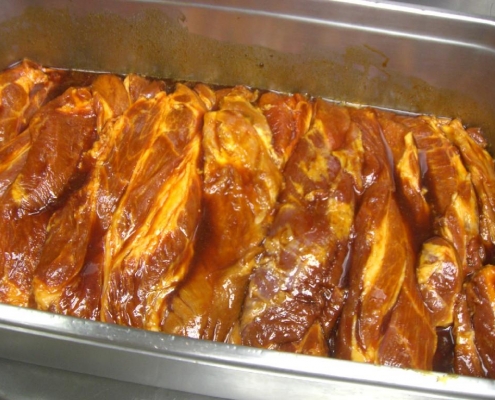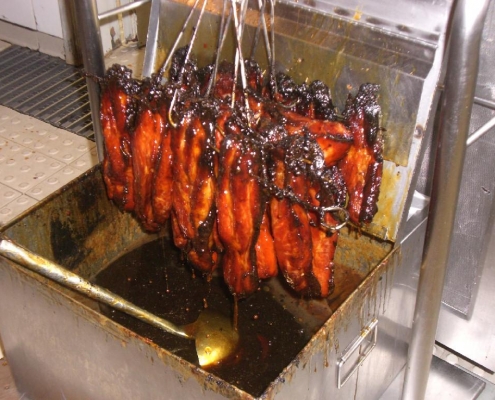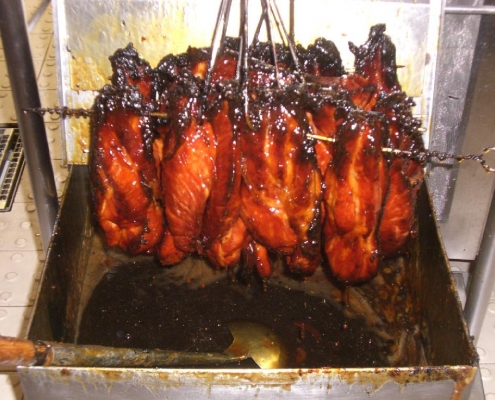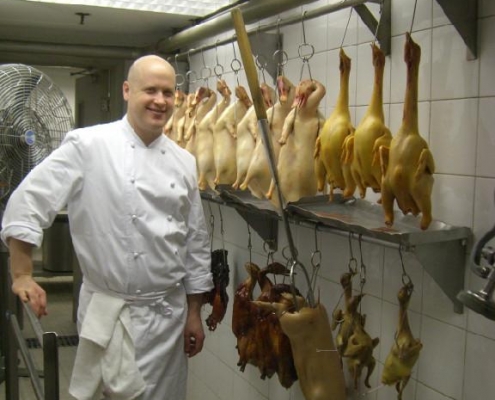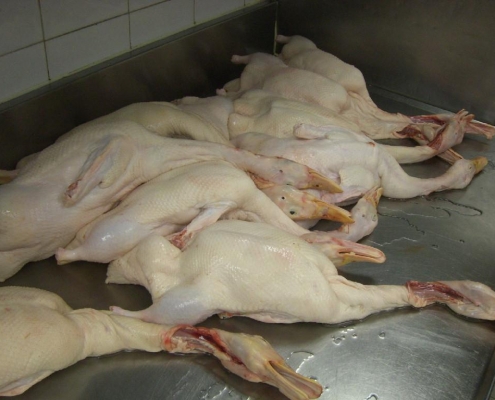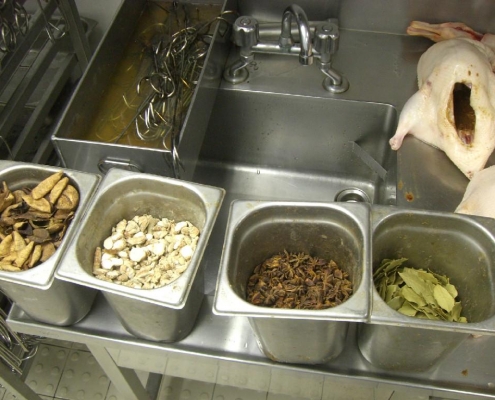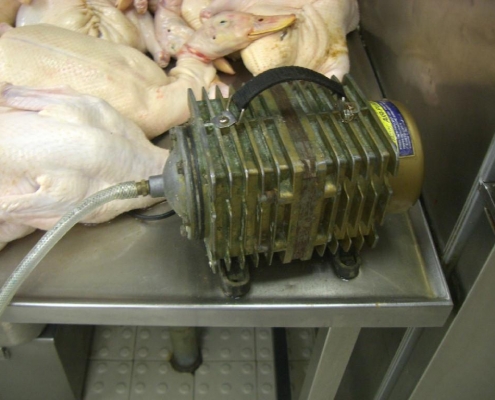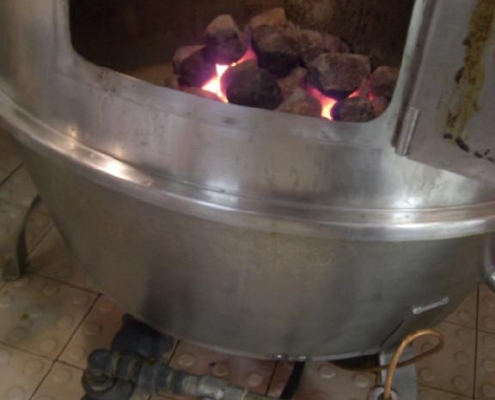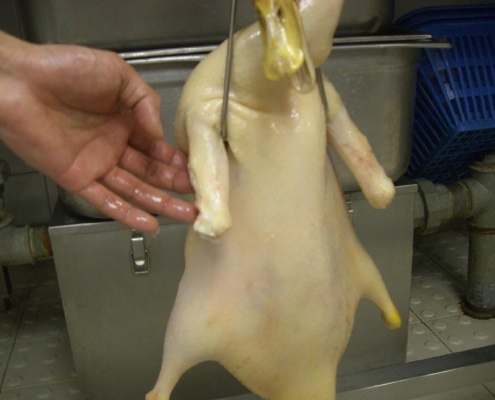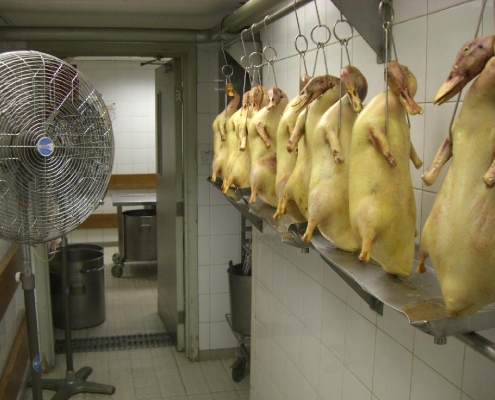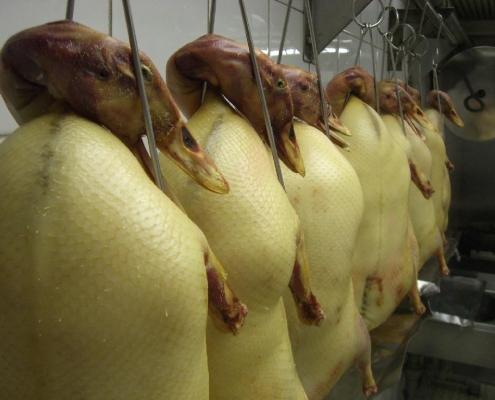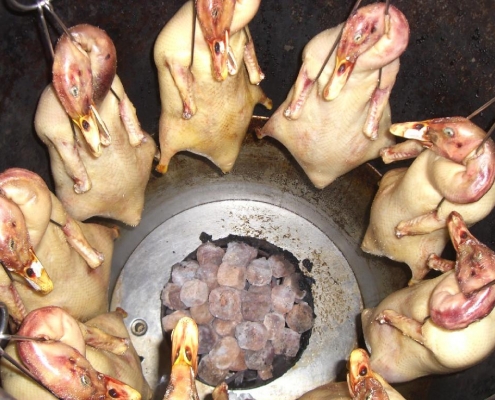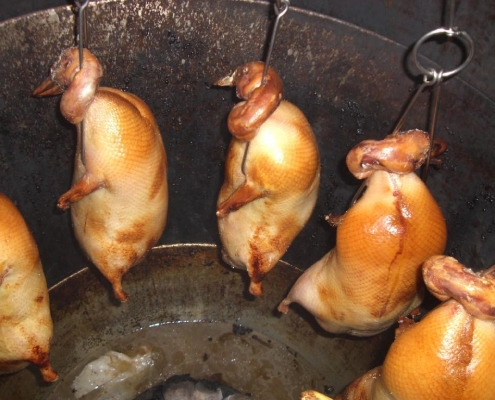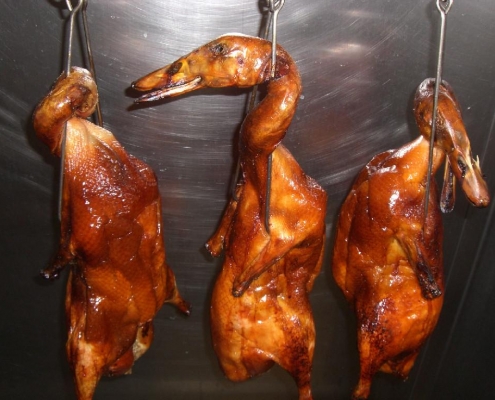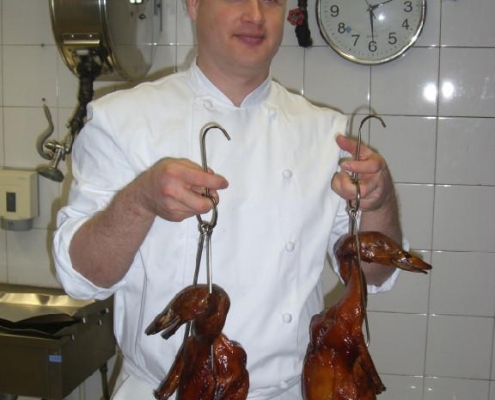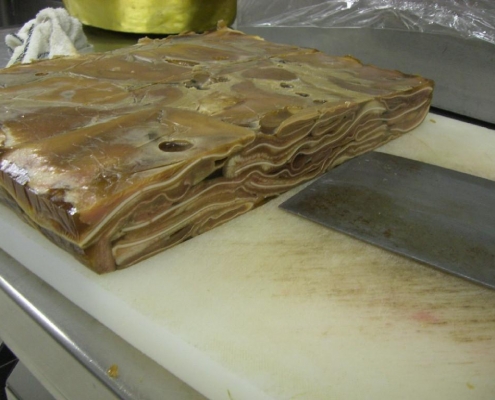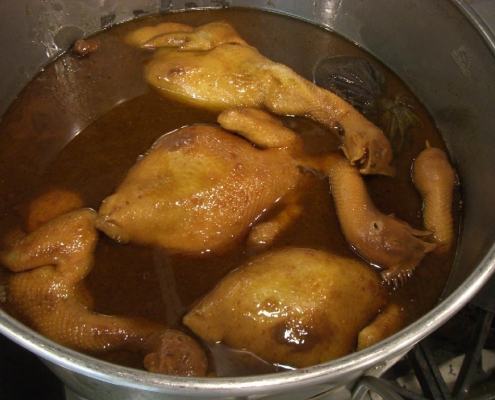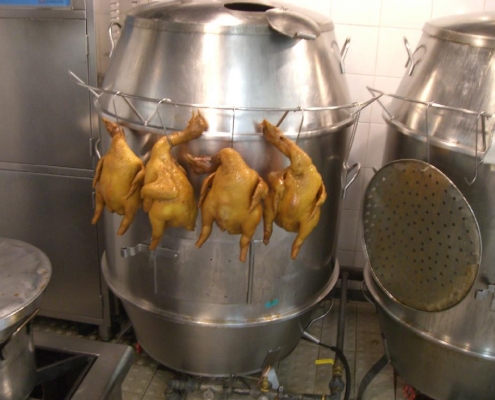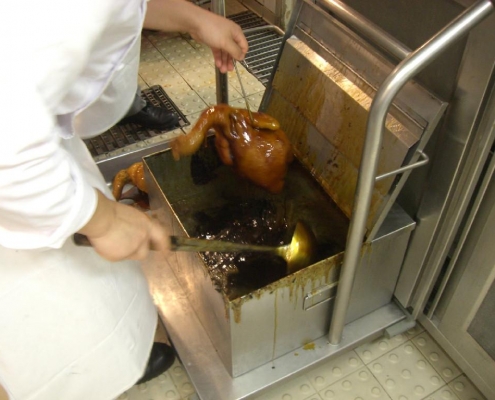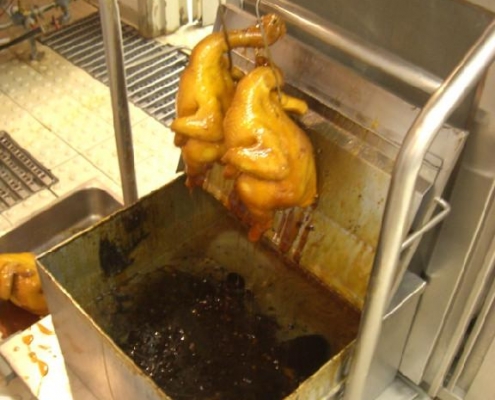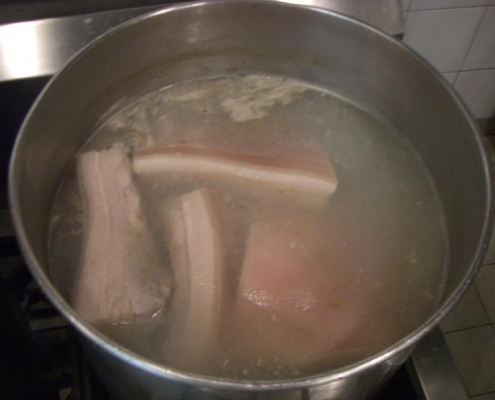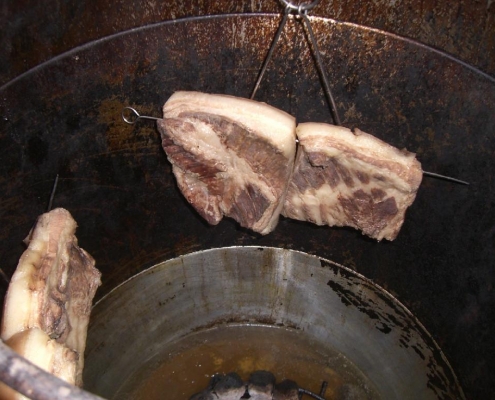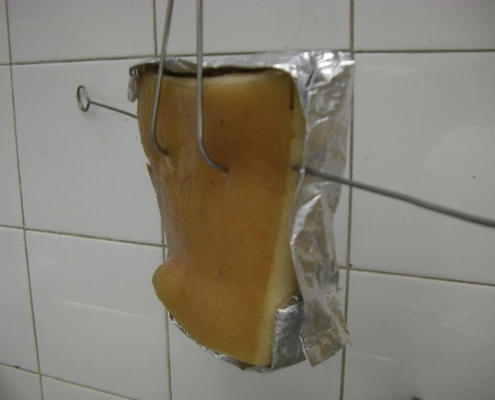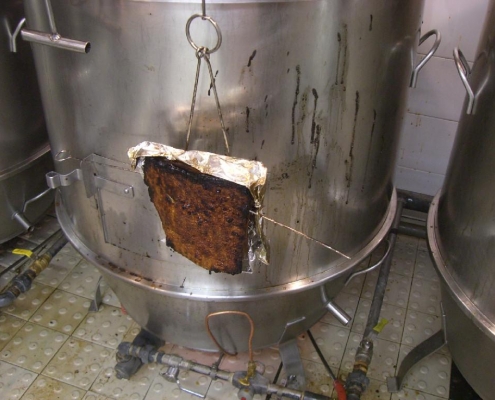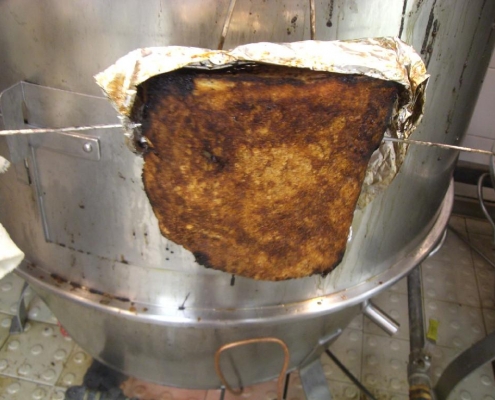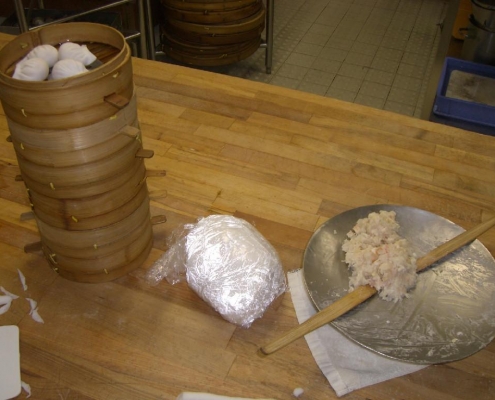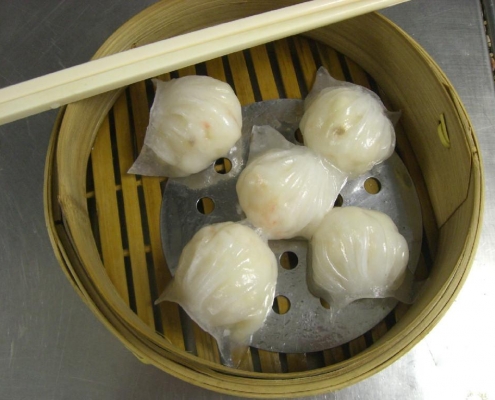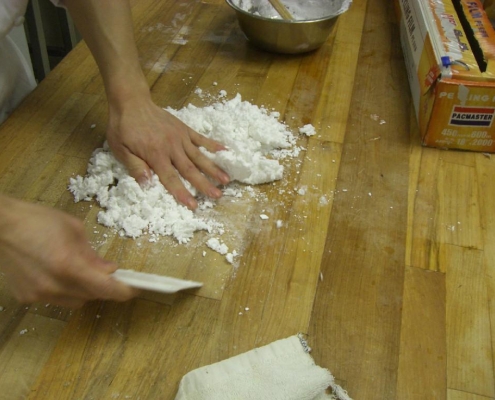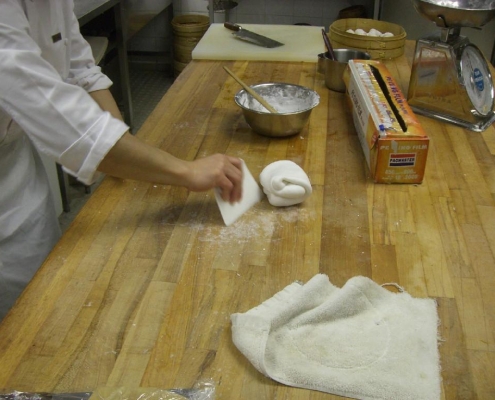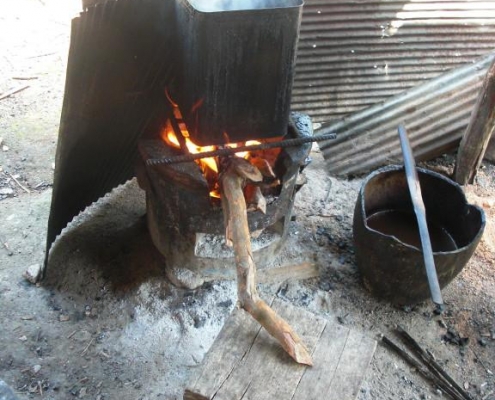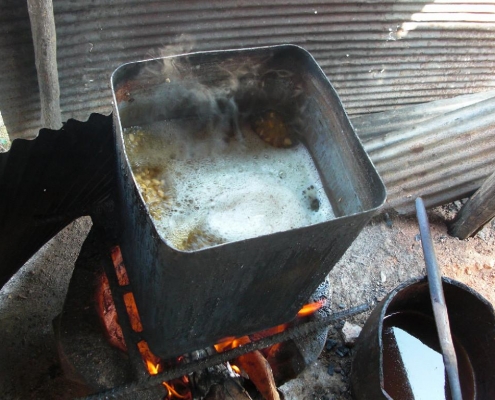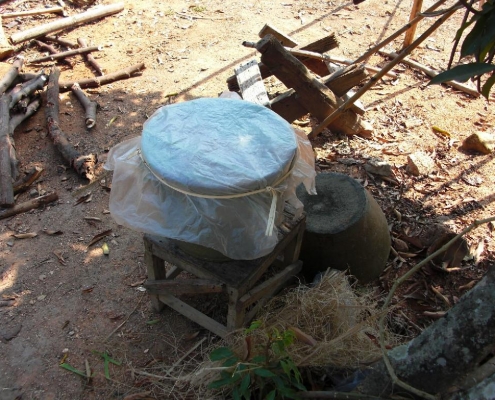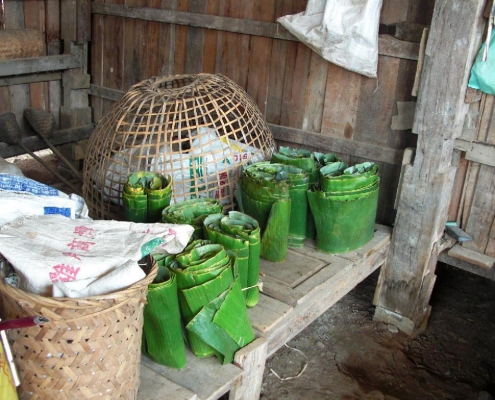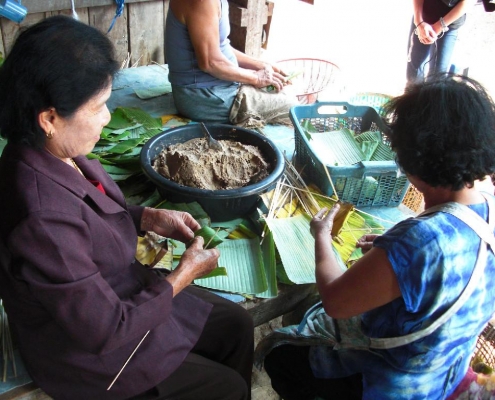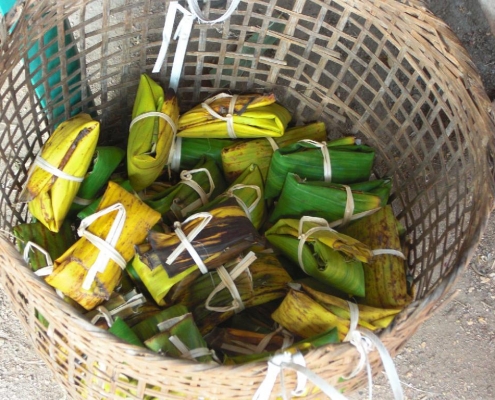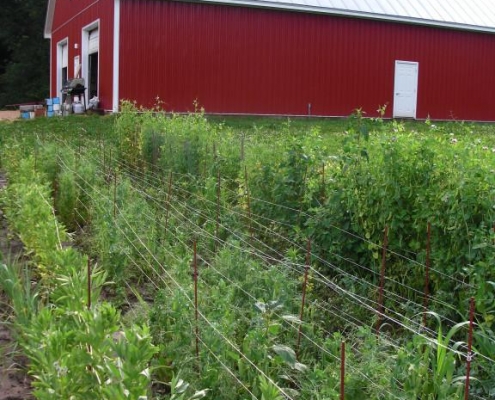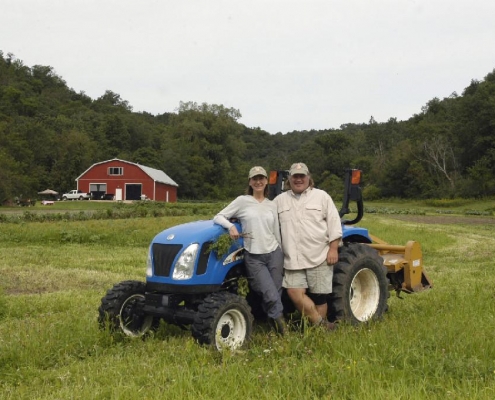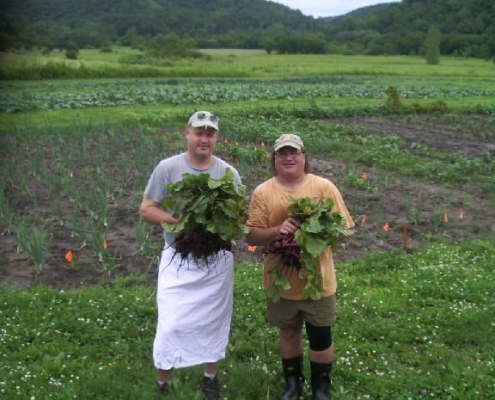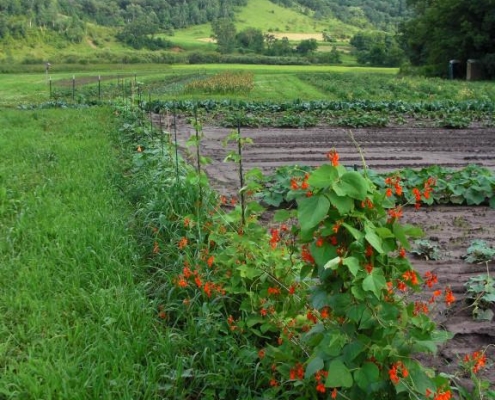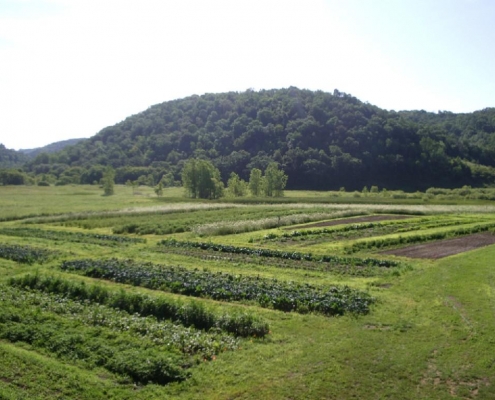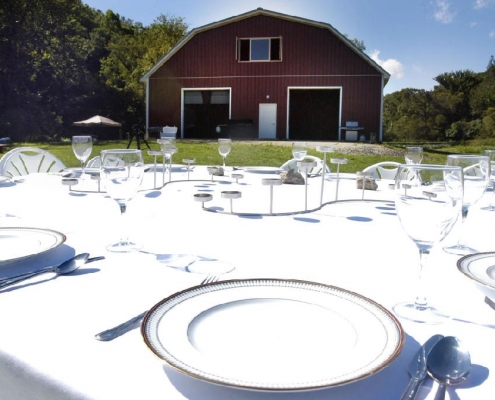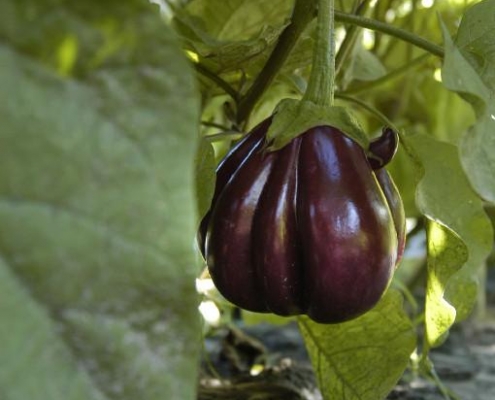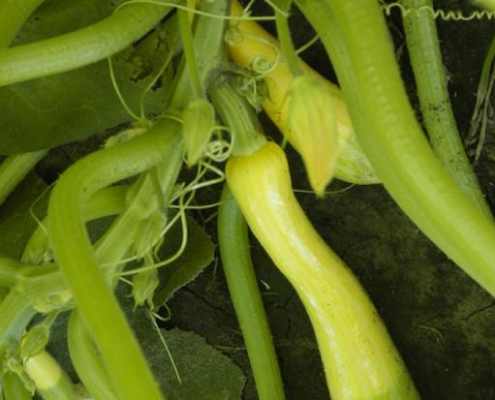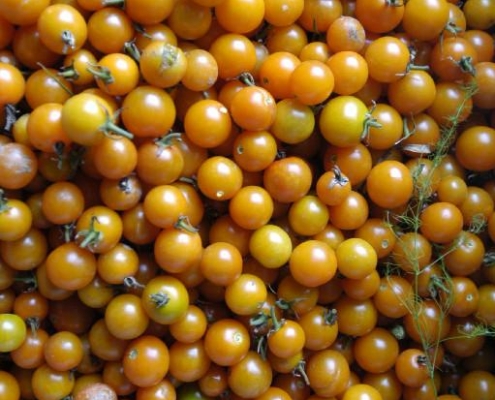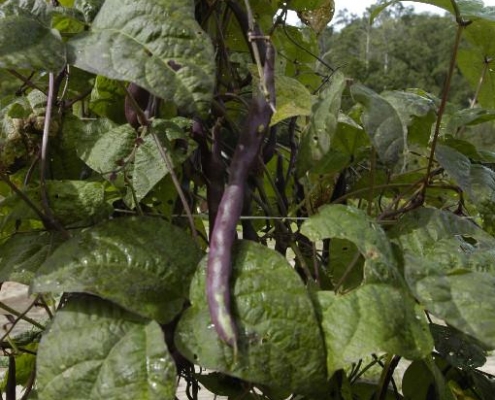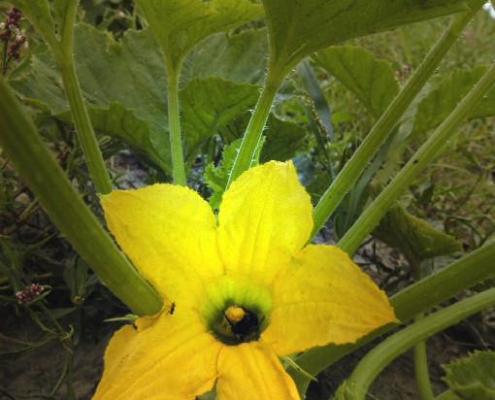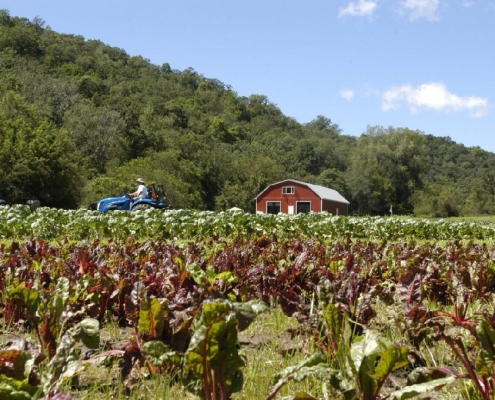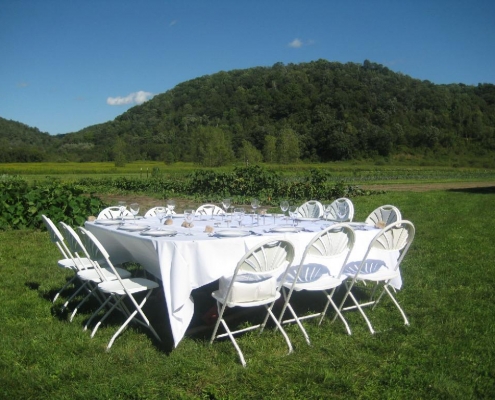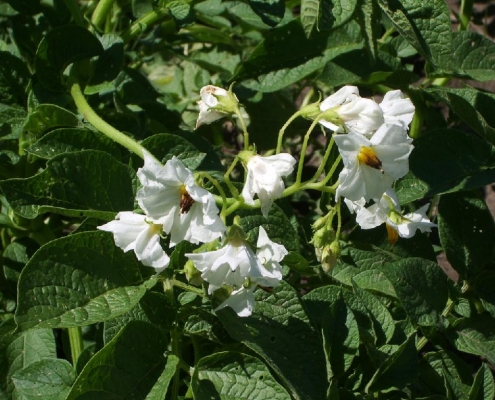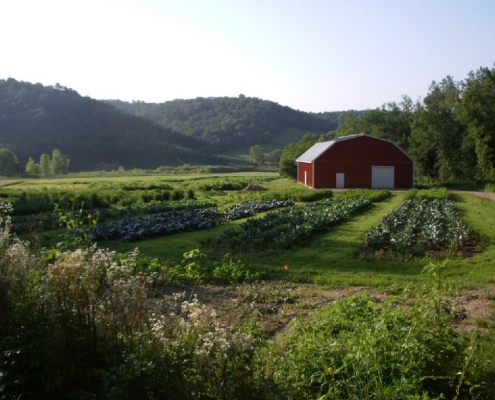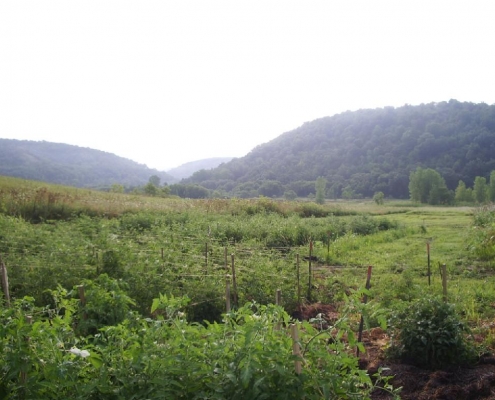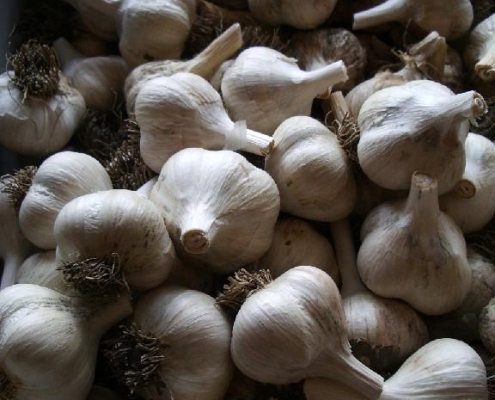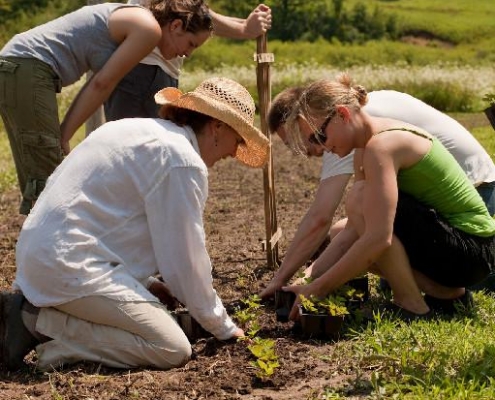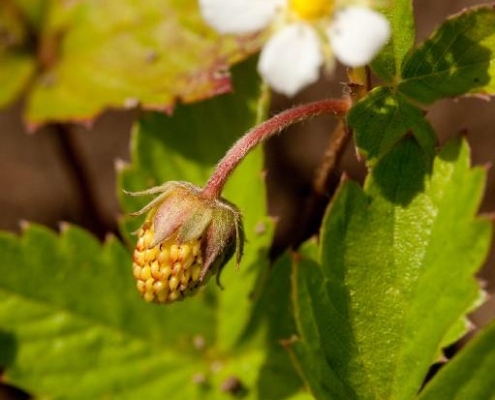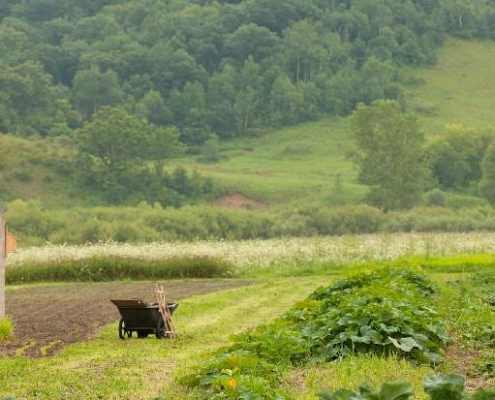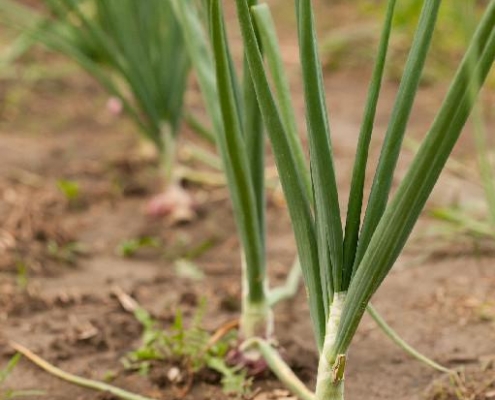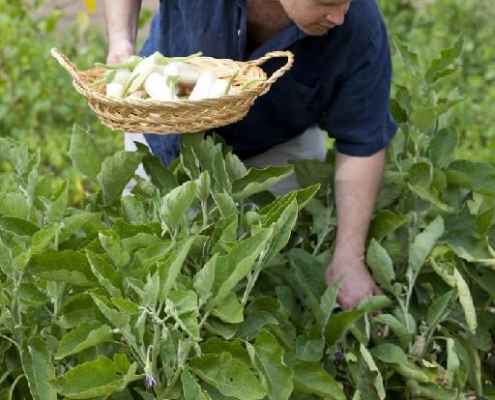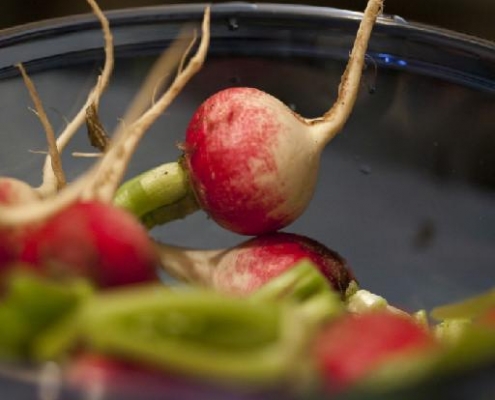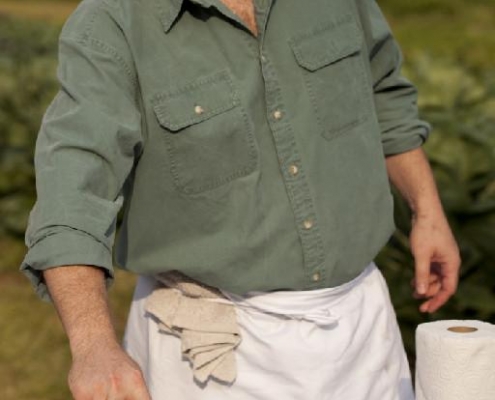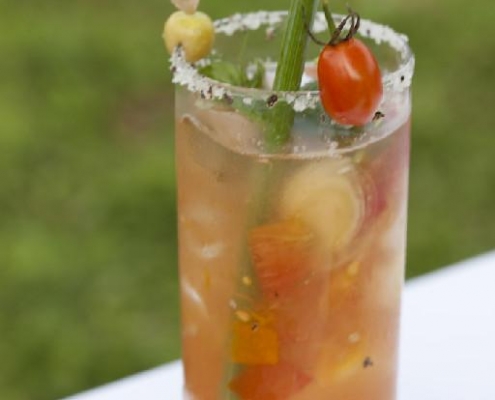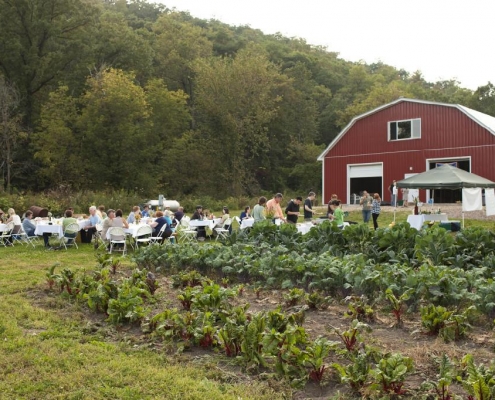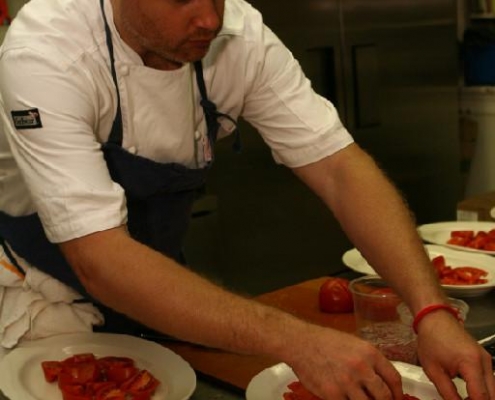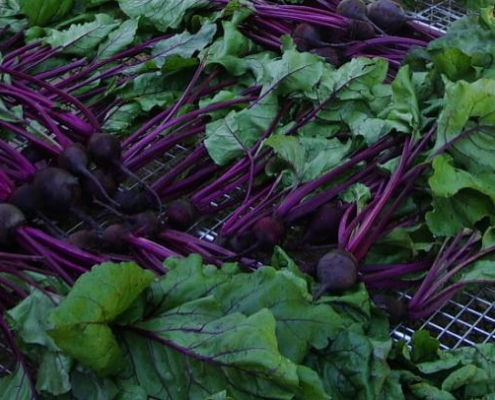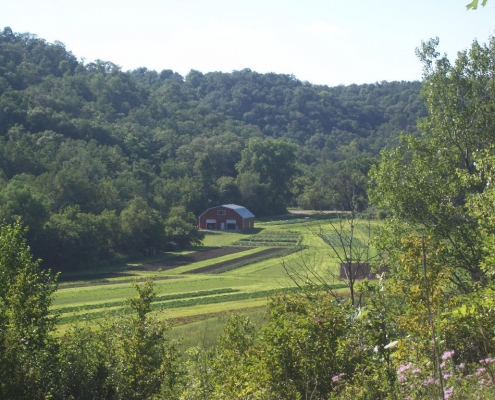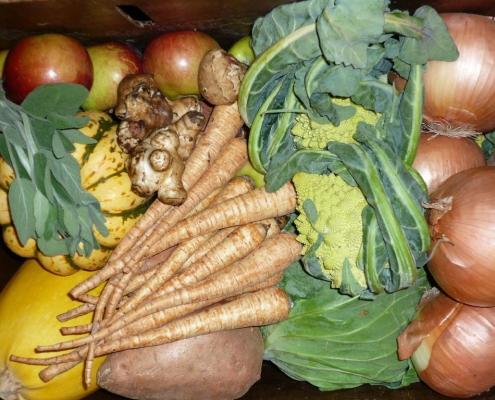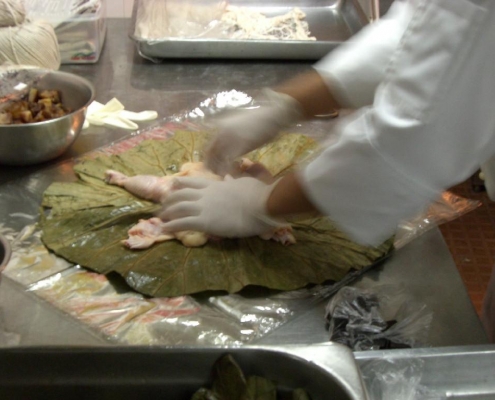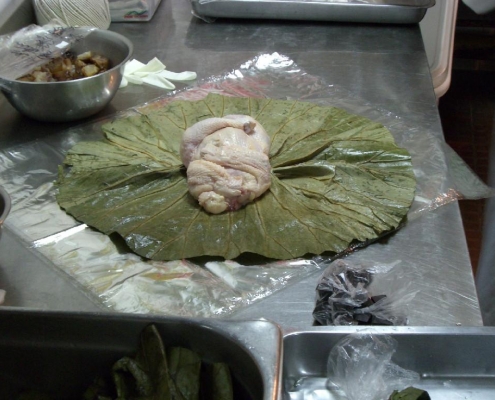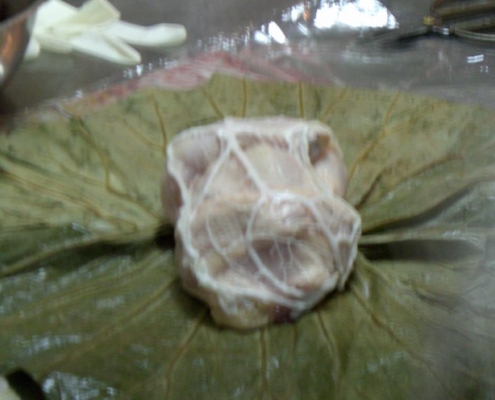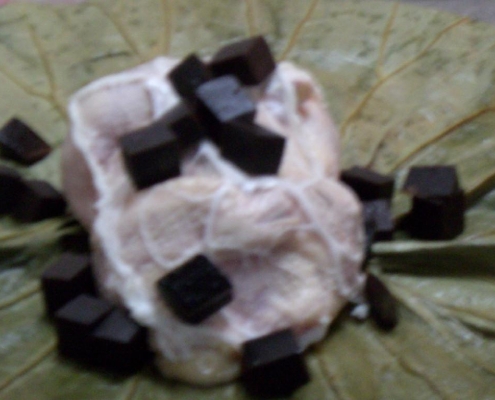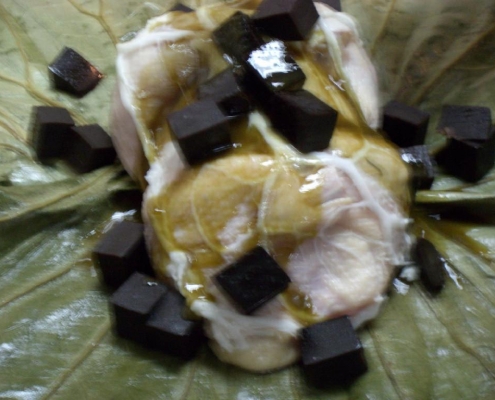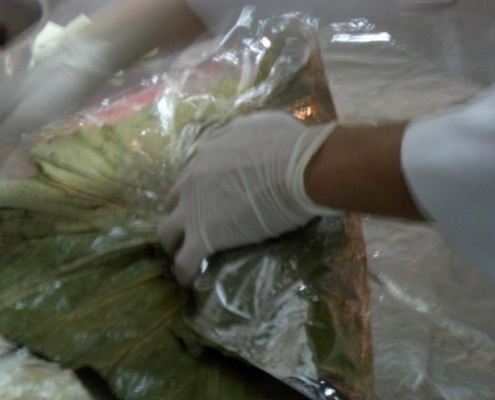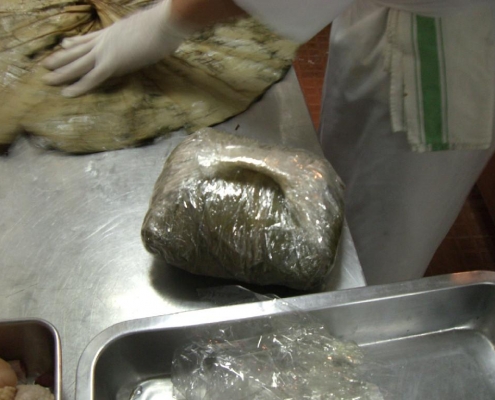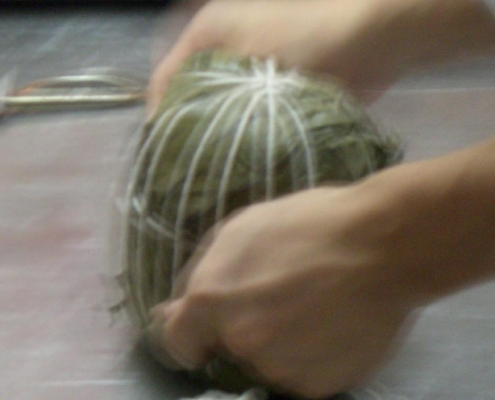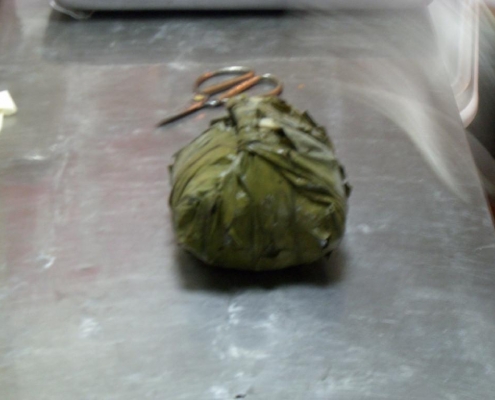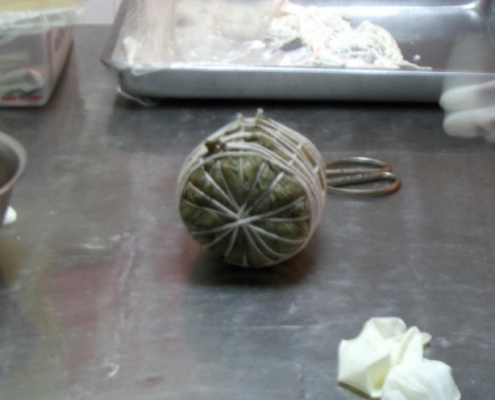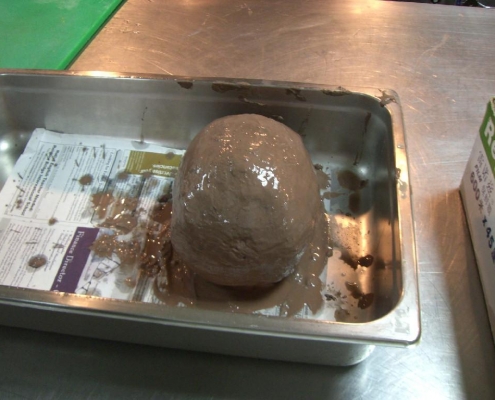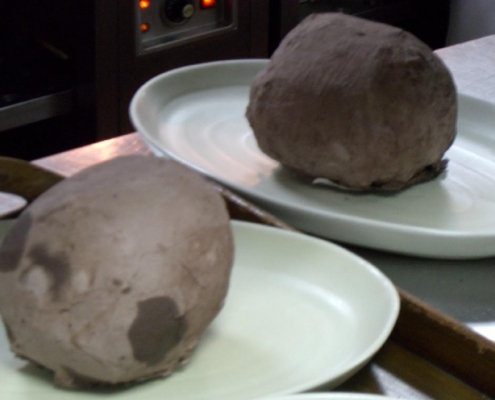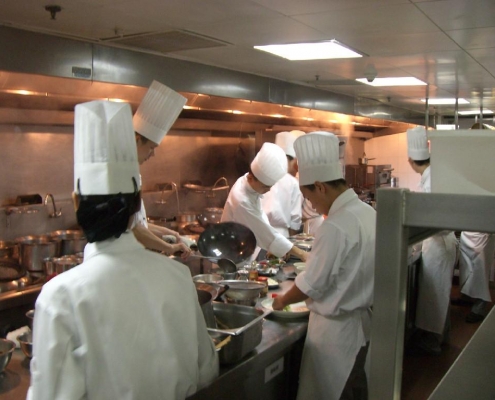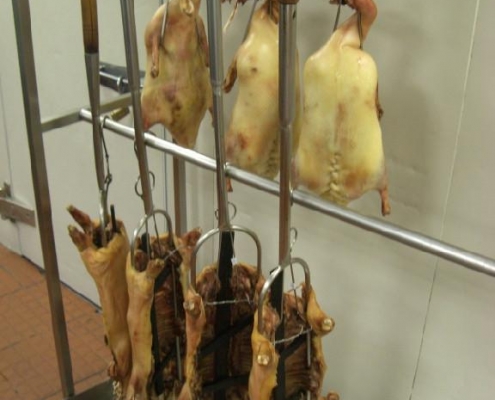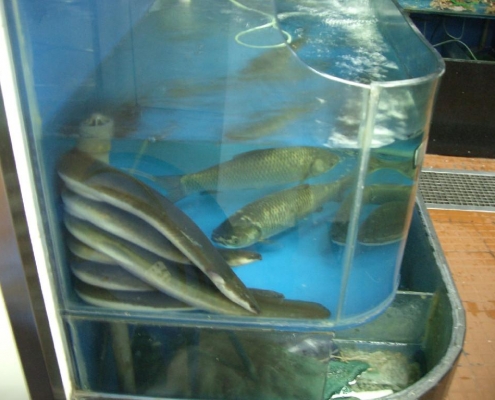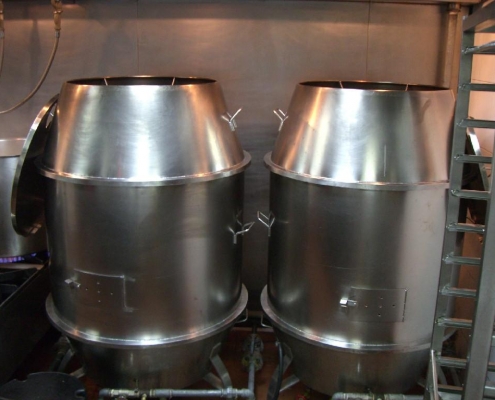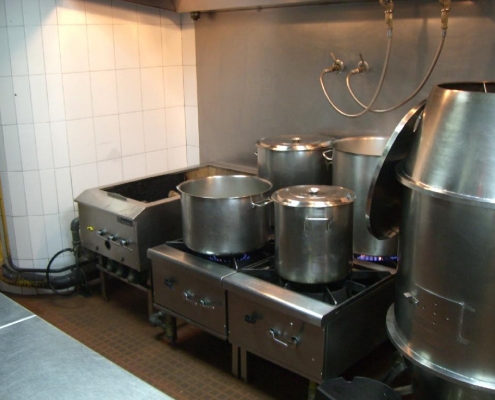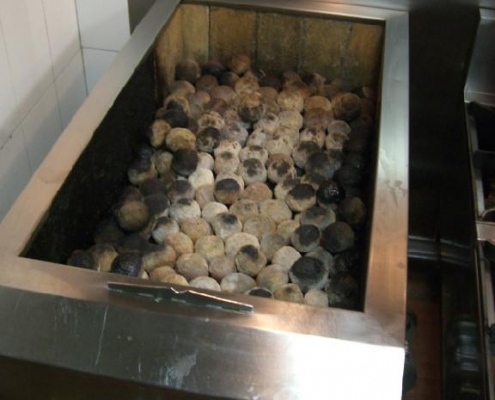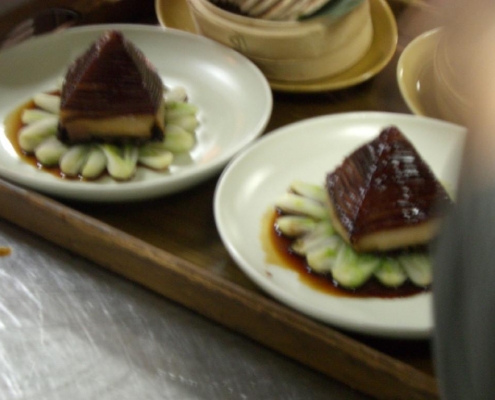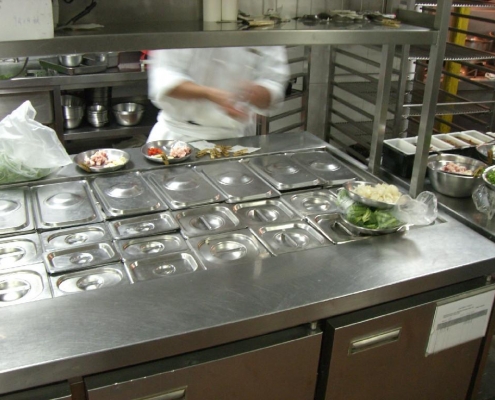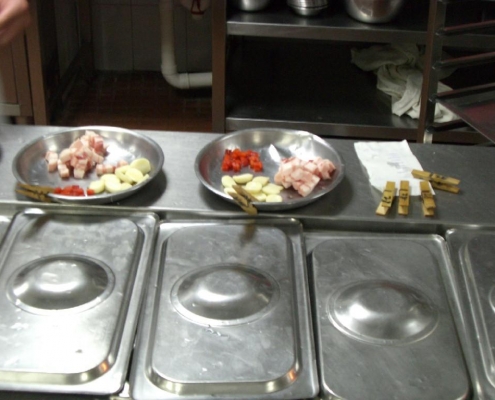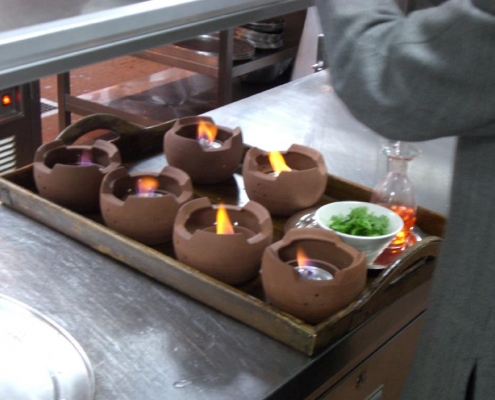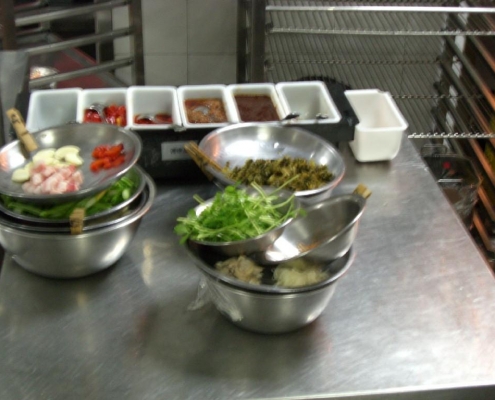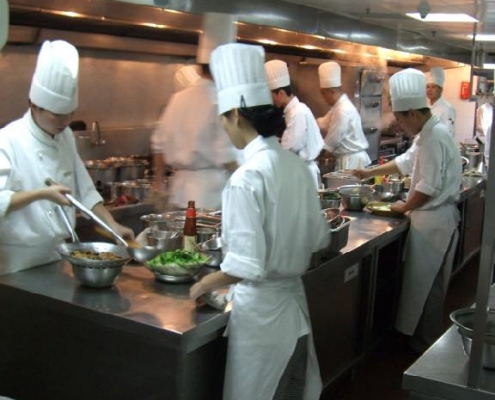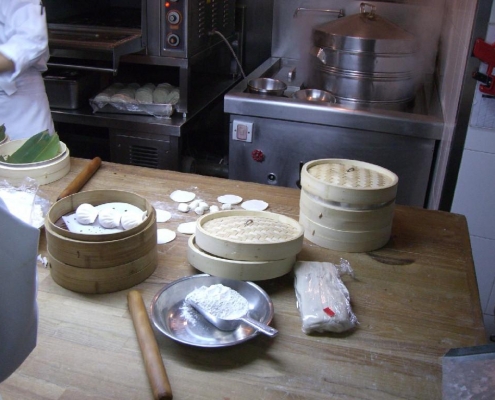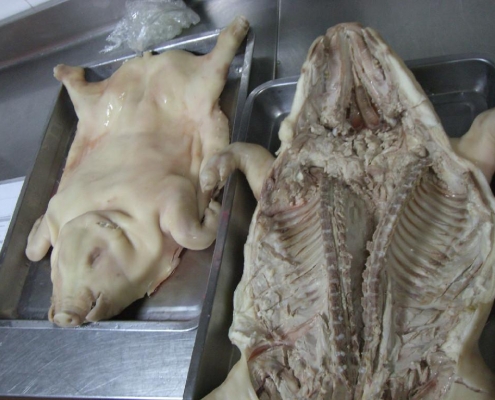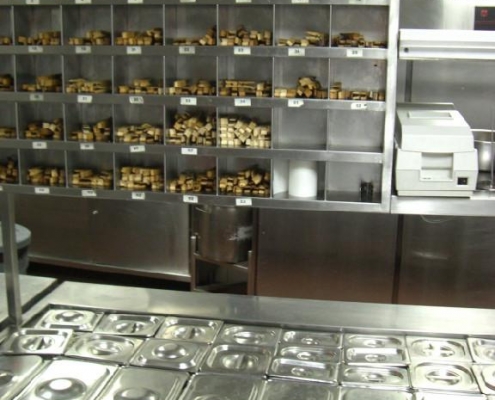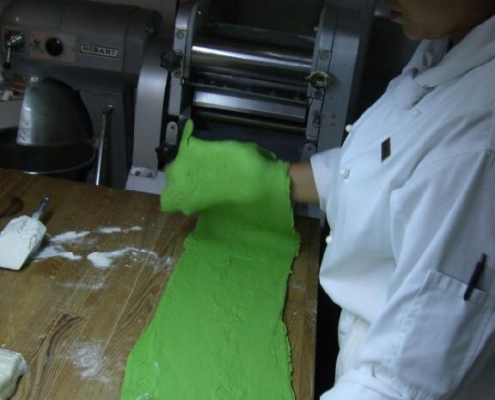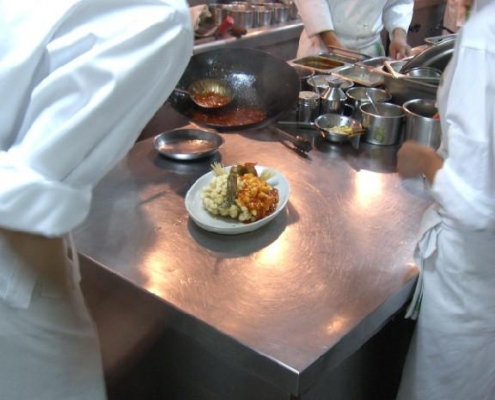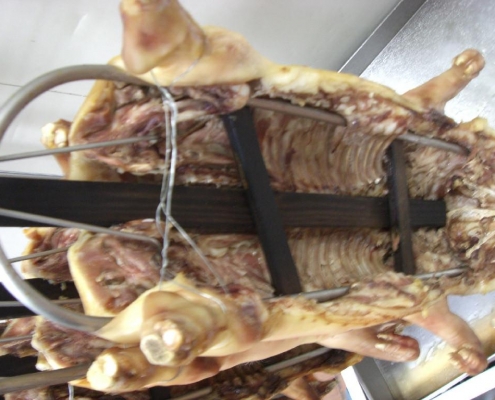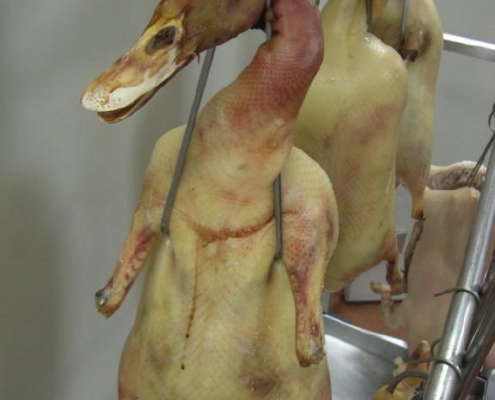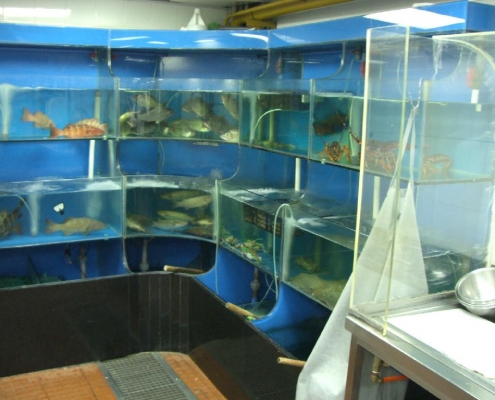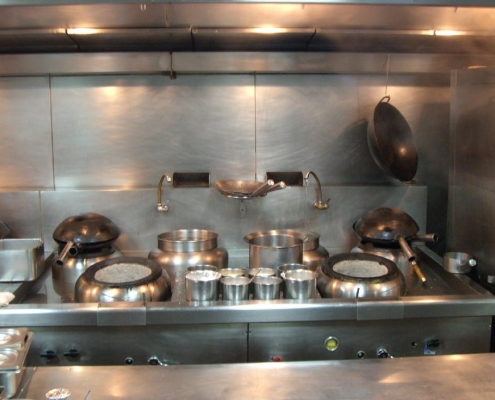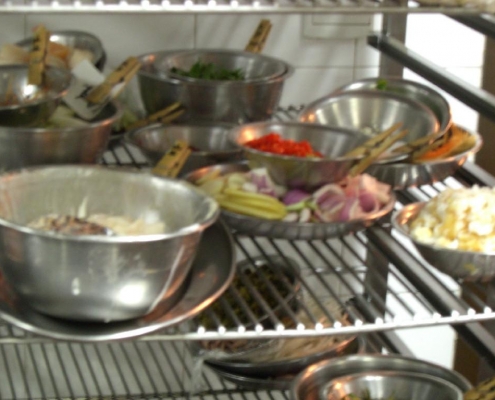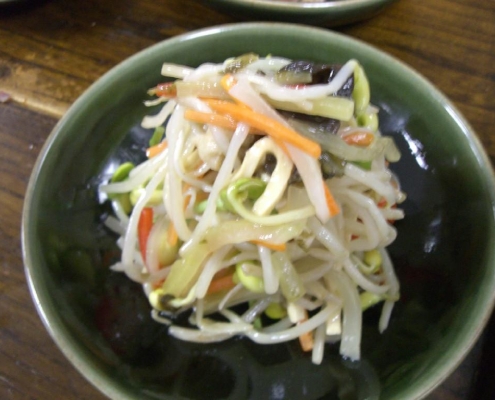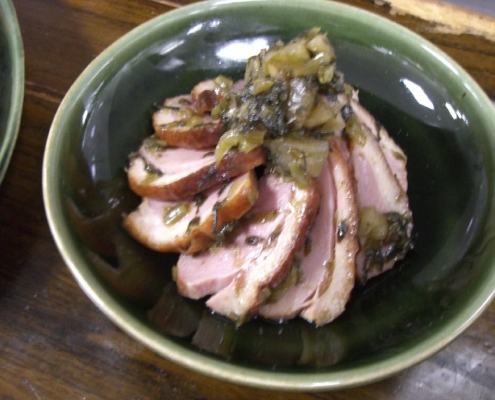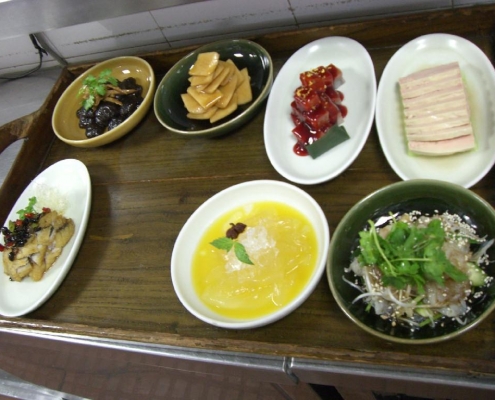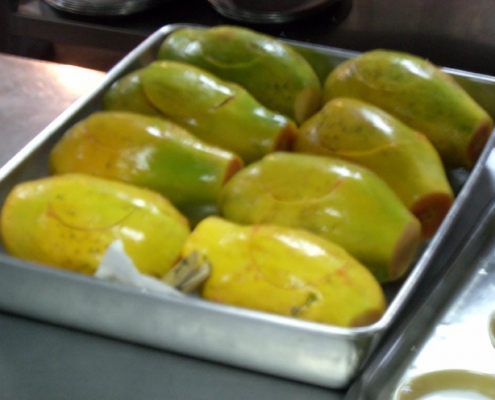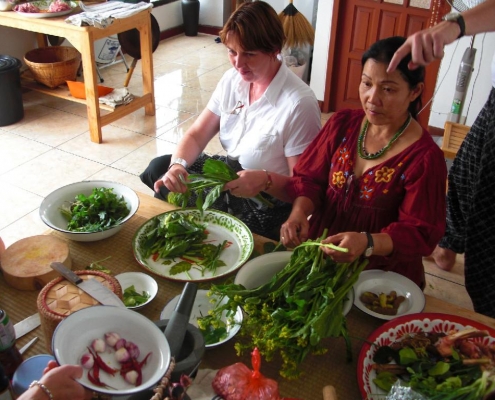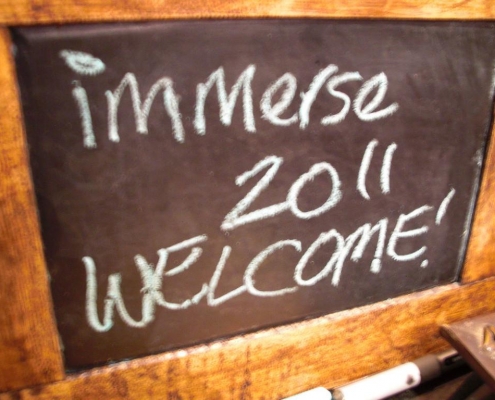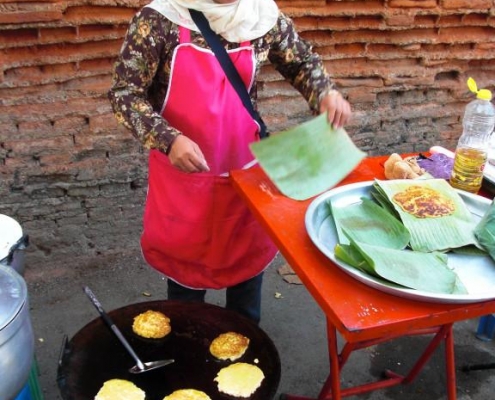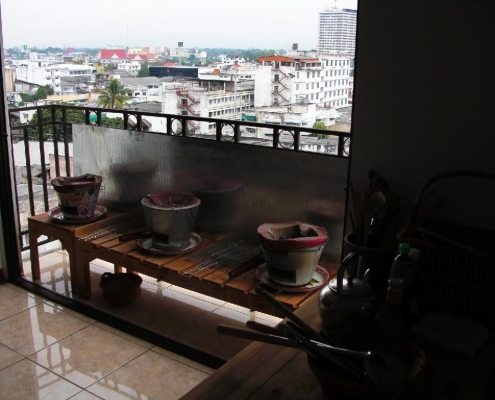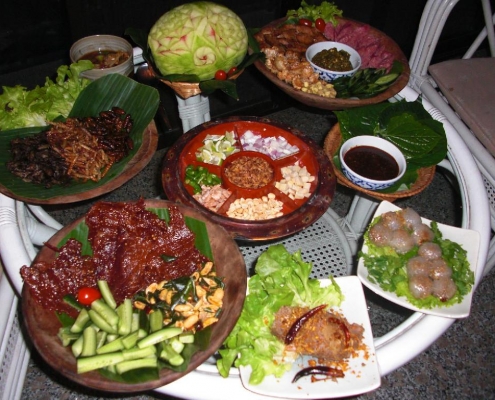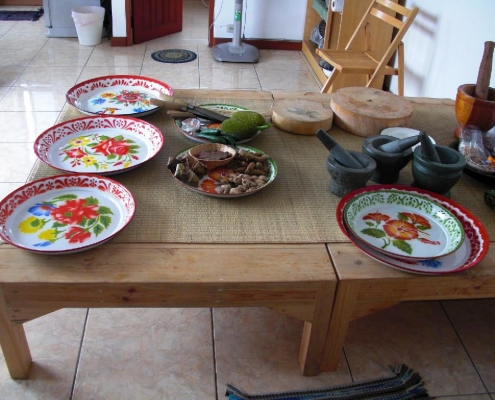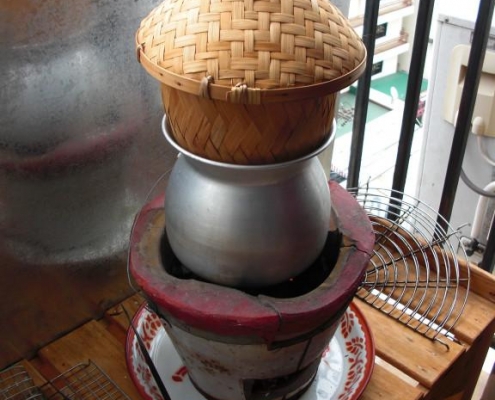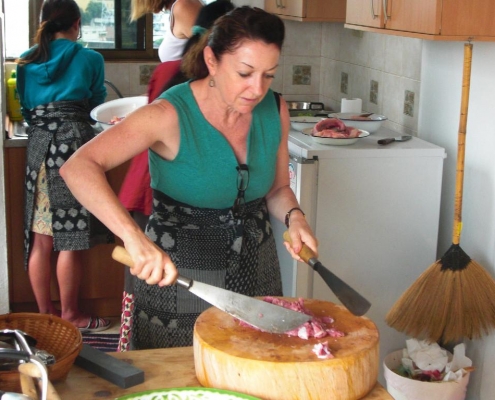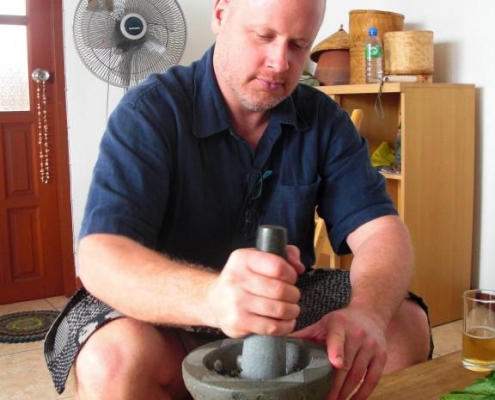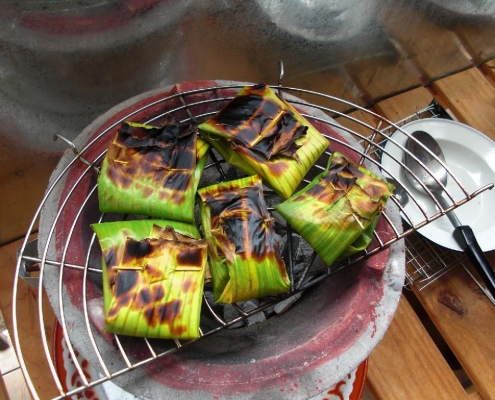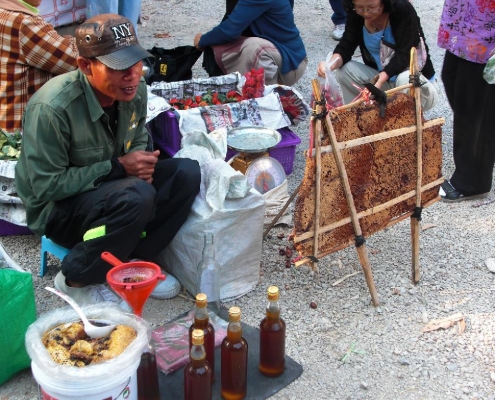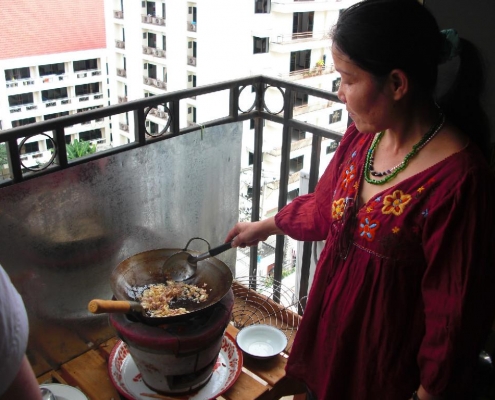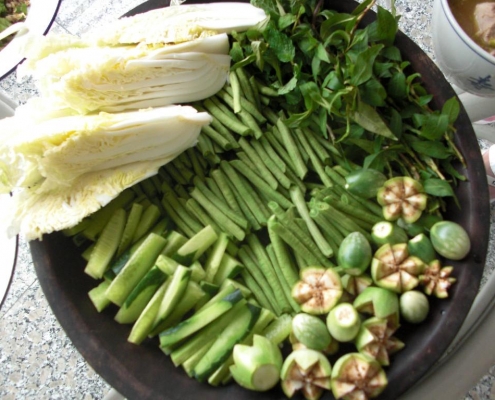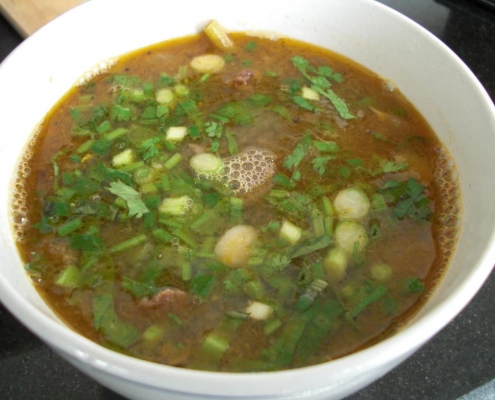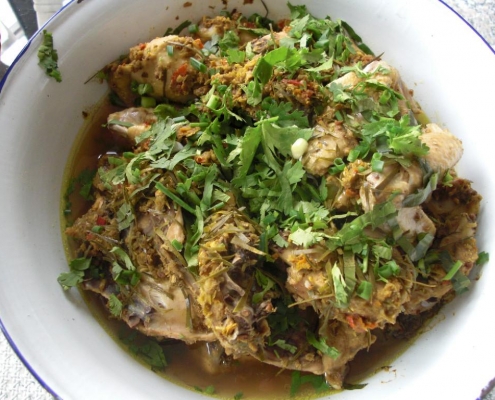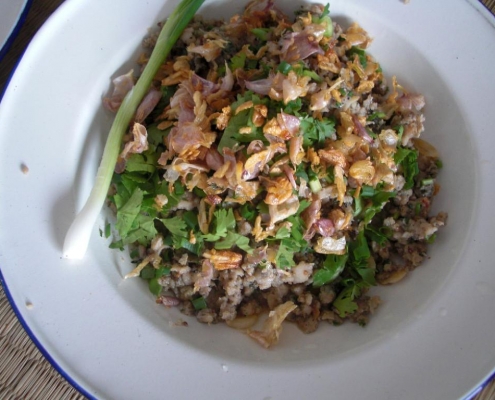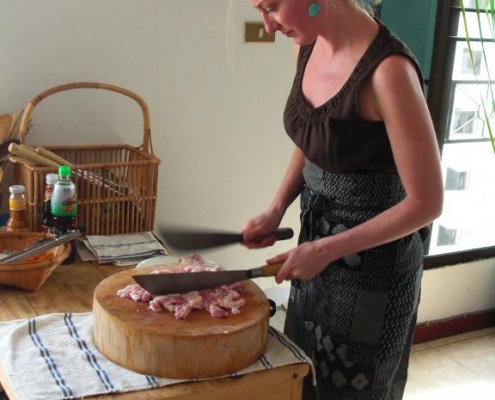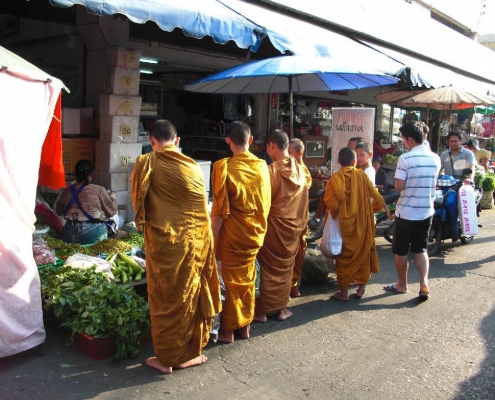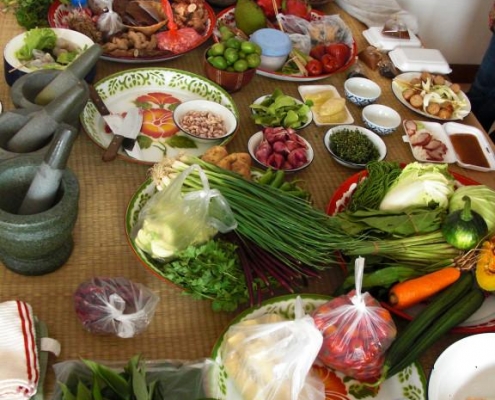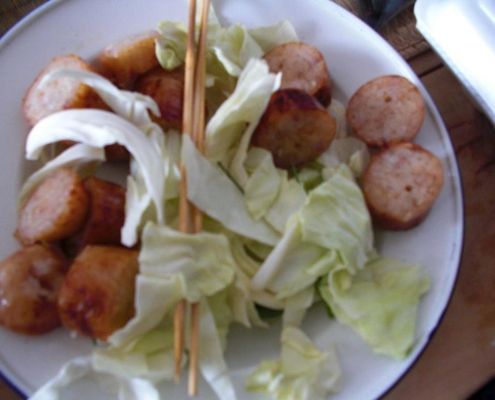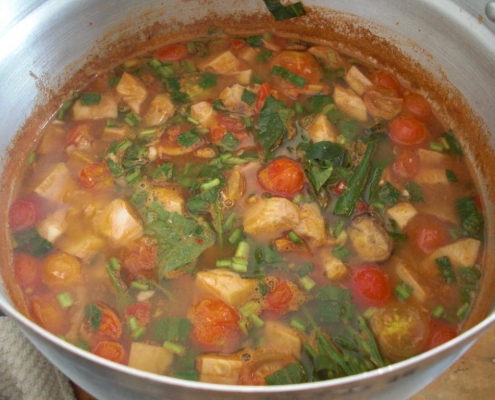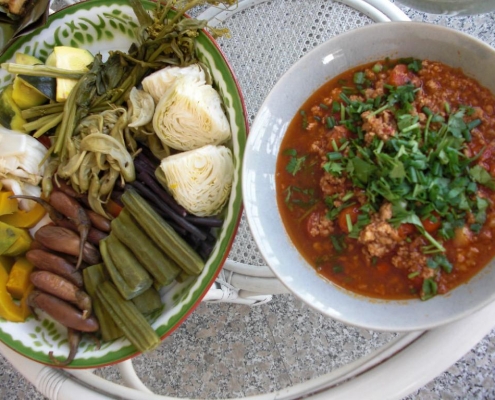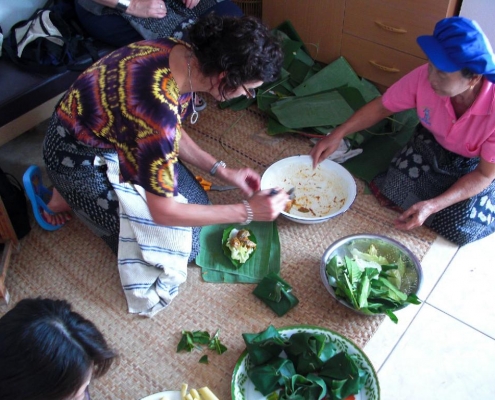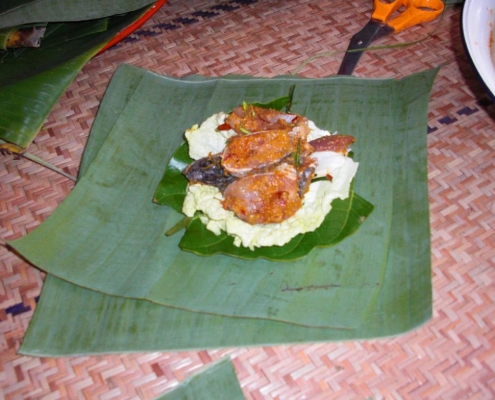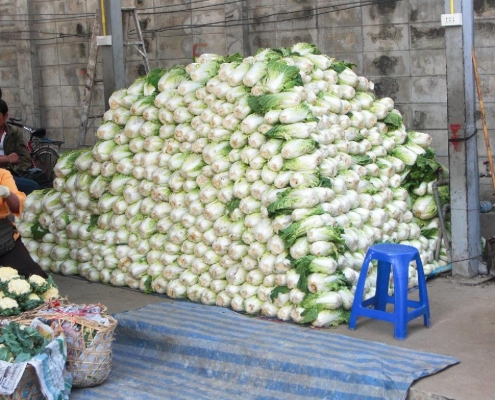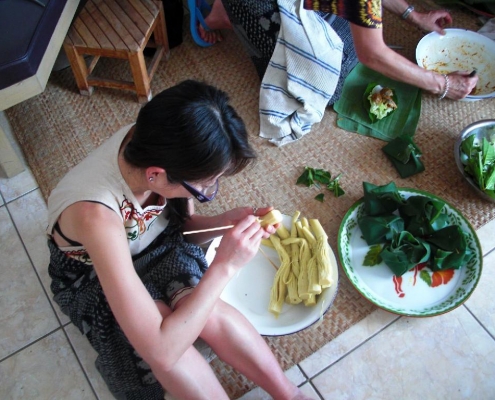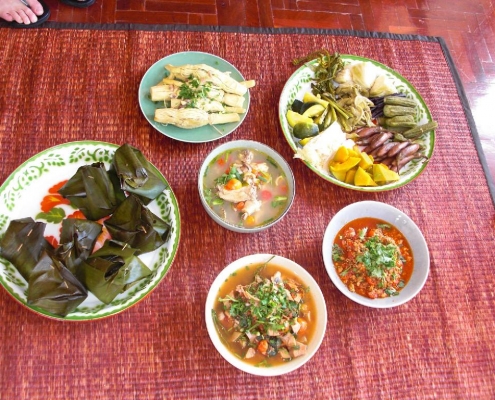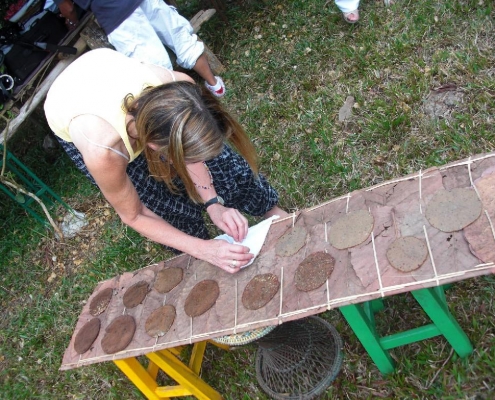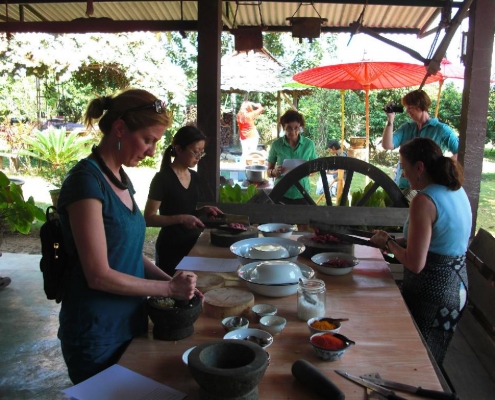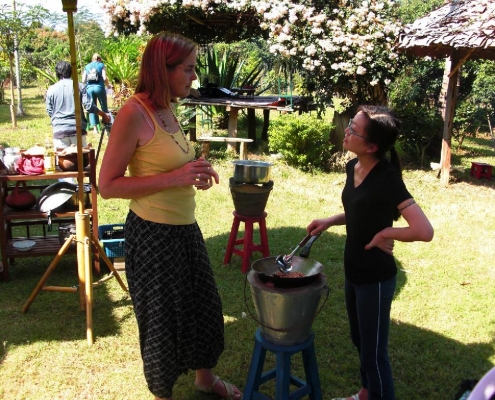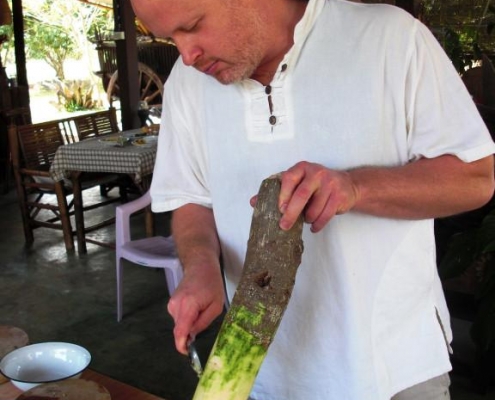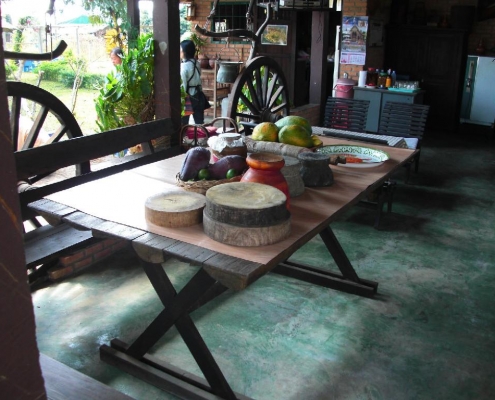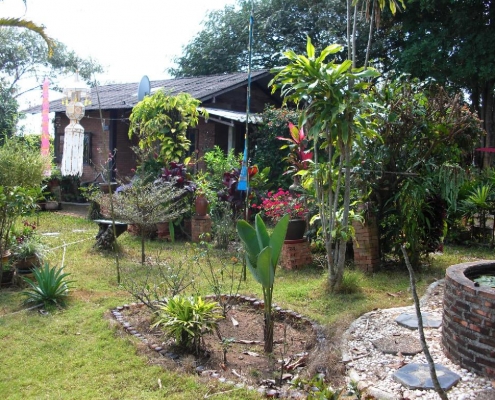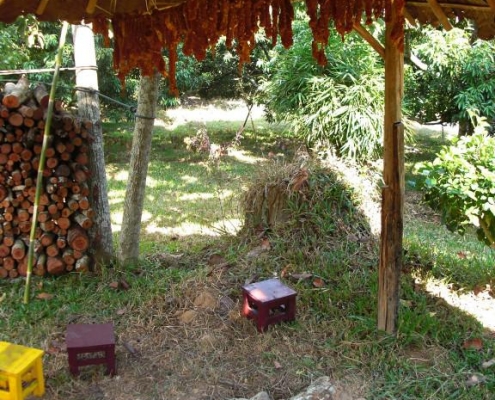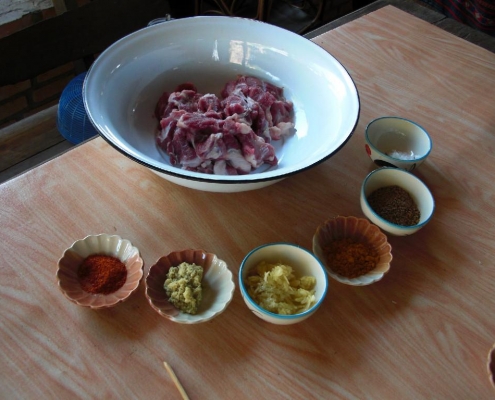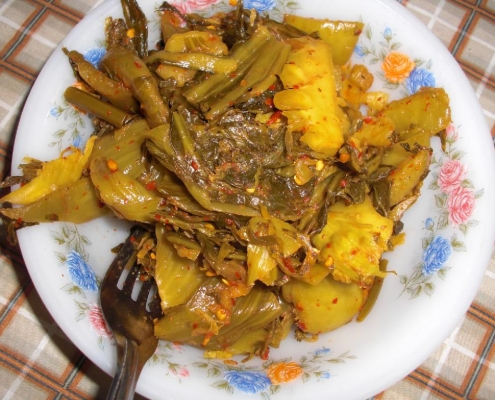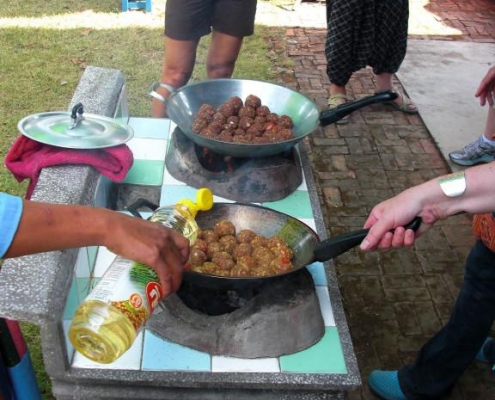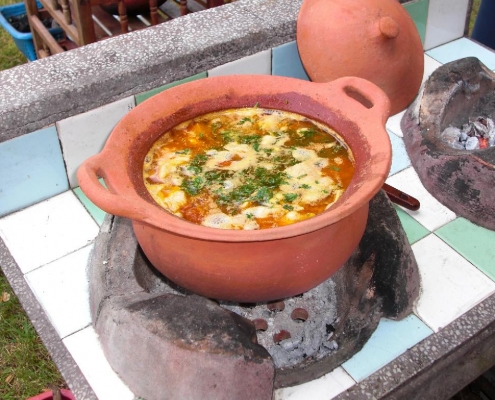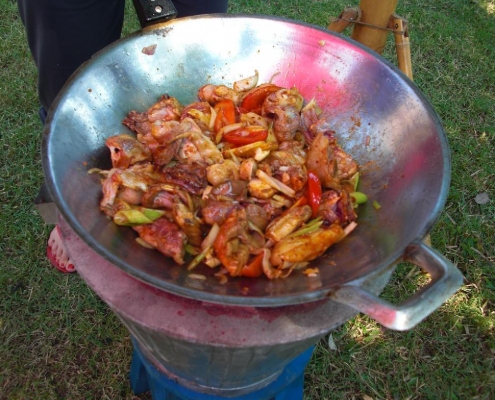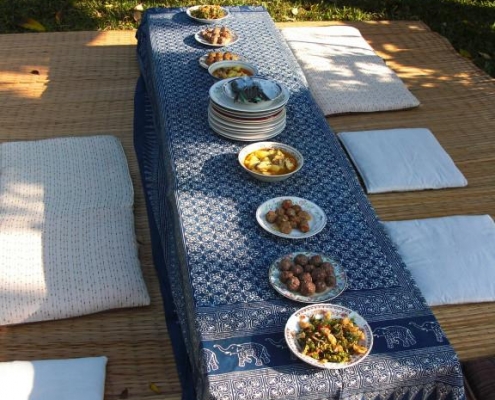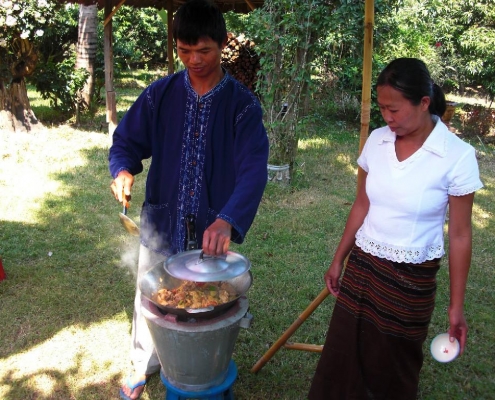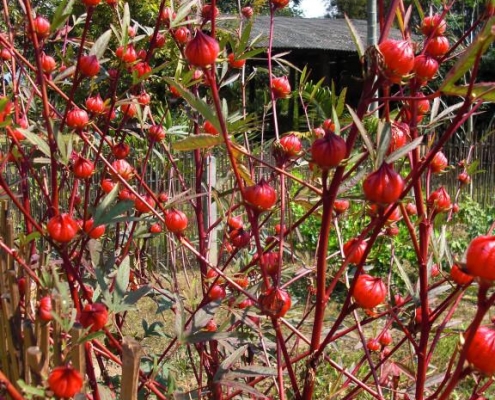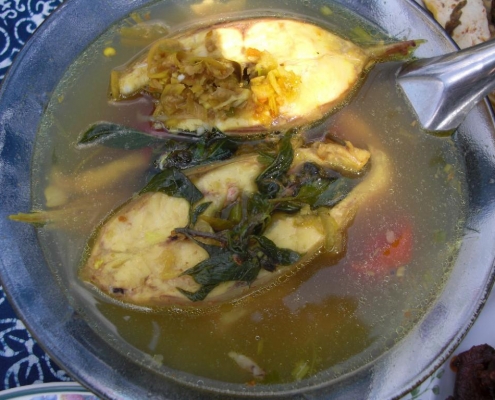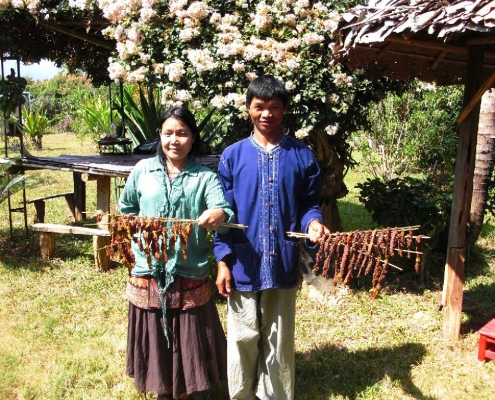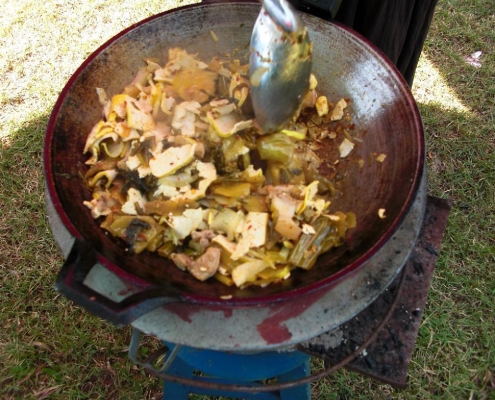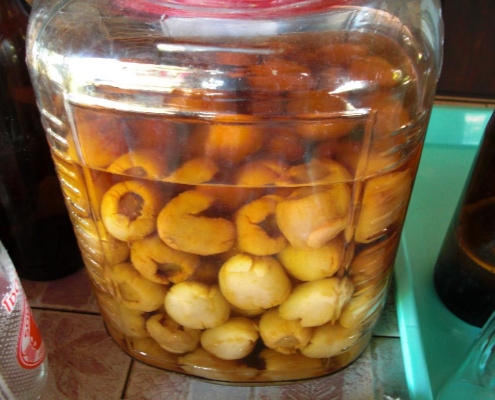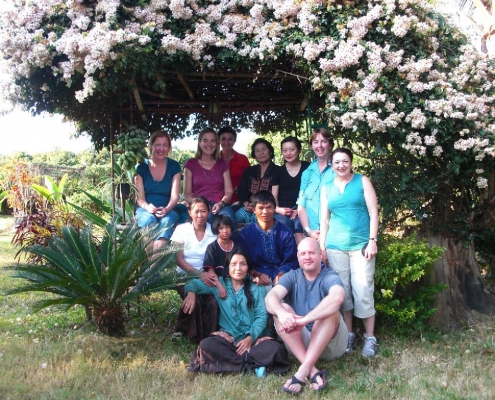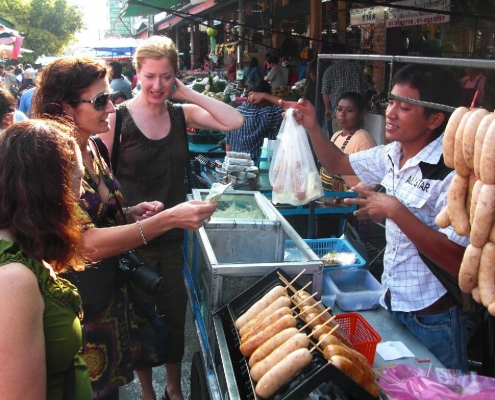I spent a week at Made In China the Northern Chinese outlet at Grand Hyatt Beijing. The main goal was to learn about the techniques for preparing traditional Beijing Duck. The procedure is complex and takes 3 days-far beyond the preparation for Hong Kong style duck. Thus far I have yet to eat a proper Beijing Duck outside of China though I have seen a number of attempts. Best to try the real thing and if that means making the trip to Beijing than go.
Crazy is this experience. During the pre-opening of the Park Hyatt and all its delays left me with actual weekends off. I decided to take a cooking class and sought this place out. It was a typical vocational school set off the 4th ring road on a side street in a local apartment building with no air conditioning, heat or elevators. They were reluctant to take me on but in the end I had my secretary convince them to let me do a Hunan cooking module. I would go on Saturday and work through approximately 40 dishes working with the owner/master chef. The translator for the sessions was this old man who was a theoretical mathematician that lived through the “big event” and told me how he was taken out of the university and sent to the fields to work. Strange, he still called him “our great leader” after all he went through. The instructor had major chops when it came to cooking-complete with cigarette hanging from his lip while he threw product in the wok at hyper speed. He had a cough that was TB like but a laugh and spirit that was open, kind and serious. All said and done this was one of the coolest things I have done when it comes to my study of food. Might I say that Hunan food is the spiciest that I have ever experienced. The use of the chile was by the handful.
I had a plan on my recent trip to Tokyo which was to revisit a few of my favorite ramen shops to study how the bowls noodles were composed, have an evening of laughter and revelry with my old staff of cooks that worked for me at the Grand Hyatt and take a class on how to make soba noodles. The last item was something that has been hanging in my mind for years as it was always my intention to take this class when I lived in Tokyo. But when you are running busy restaurants there can be little time in life to do anything other than that so at that time I shelved the idea hoping to revisit the possibility in the future. Mission accomplished.
The location of the class is in a neighborhood called Shitemachi or the old downtown, specifically in the restaurant supply area called Kappabashi. I am very fond of this old neighborhood and have many small eateries that I frequent when I travel to this part of town.
The first day of this class was a challenge for me because I was out with my old workmates until 4A.M. and my class was at 9A.M. Back in the day this would not have been much of an issue but I have to say, these old bones were challenged. As I boarded the Ginza line (at 7:30) I quickly began to doze as the train rocked along. There is a subtle art to falling asleep on a Japanese train as its usually packed like a can of sardines. I have scene people fall asleep standing up in a crowd. Luckily I got a seat in the corner and drifted off to a fidgety sleep where I dreamt that I missed my stop-ahhh to be back in a big city where neurotic behavior fuels the beast. I heard “Ueno eki” in my dream and leapt up and jumped off the train-perfect timing.
When I arrived Chef Kochiro Morihana, the owner of Restaurant Menkobo, greeted me and ushered me through the dinning room to the back workshop area. He has a number of work tables set up complete with lacquer mixing bowls, various lengths of rolling pins, an assortment of soba bochos (soba knives) and so forth. Against the back wall are bags of buckwheat and different flours and in the center is a mechanical stone grinder that plods along turning buckwheat grains into fine white flour. I am excited.
The week’s classes will cover the classic buckwheat soba, udon, green tea soba and shiso soba. We start with the basic buckwheat soba-only 2 ingredients-four and water but there are many variables that play into this. Like many things in Japan-simplicity just means complex in disguise. Chef explains to me the difference between winter and summer wheat, the effect of humidity, temperature of the water, the difference between fresh milled flour and already ground and so on. We begin to make the dough. Each step he explains what’s going on, what to look for and how to adjust. I begin to understand a bit of nuance after each batch we make. Chef tells me he has been doing soba for over 20 years and is still searching and learning.
After each batch of soba is made we package up the fresh noodles and I get to take them with me. I give them to old colleagues who bring them home to their families. He also brings one serving into his kitchen and we make a batch for me to sample after the class is over. I live for experiences like this-sitting middle of the workshop at a cart table eating the noodles I just learned to make.
In Japan noodles are the fabric that holds the country together. They are the food that all people eat at all hours and in my opinion can reflect the essence of Japanese food-that being the illusion of simplicity. Think again the next time you taste a zaru soba or dive into a big bowl of chewy udon-realize that the culinary forces behind these simple treats goes way beyond what you think.
Menkobo Soba
www.mencobo.jp
03-5806-1281
This place, The Sichuan University of Higher Cuisine is the same place that Fuschia Dunlop studied. She has written 2 of the best books on Chinese cuisine that have ever been published. I have traveled to Chengdu a few times and always enjoyed the city but thought that the school was a bit full of itself and over priced for what I learned there as opposed to the experience I had at Yiqin Cooking School in Beijing. That being said, it still was a good experience as I got to learn how to make my favorite Sichuan dishes and spend my off hours eating lunch at the local market down the street. The repertoire of a good Sichuan kitchen is far beyond comprehension to most westerners. Chengdu and the surrounding countryside should be high on any person who wants to go to China and eat.
These photos are from a two week stage at Noble Court-the Cantonese outlet at Grand Hyatt Beijing. My goal was to spend a bit of time in the dim sum kitchen. I really wanted to learn the procedure for making ha cheong fun-those rice noodle sheets stuffed with minced pork or shrimp. But the main reason was to learn the procedure for making Hong Kong style roast meats. Ever since my first trip to China Town I was fascinated by the image of those amazing ducks hanging in the windows of those Cantonese eateries. Each day on this stage I would work with the chef de cuisine. We would prepare the product for the next days roasting: 20-40 ducks, 2-5 squab, 5 pork belly, 4 suckling pigs, loads of char siu, 5 soya chickens and then roast all those items we prepped the day before. Lots of sampling along the way.
Harvest Moon Farms LLC (HMF) is a value added farm and food company that grows certified organic produce to serve the local market of Chicago. The company grows approximately fifty varieties of crops on a 20-acre farm located in Viroqua, Wisconsin. HMF also aggregates the same varieties plus other products to expand quantity and availability from the Producer’s Guild it created consisting of other farms within fifteen miles of its operation. The company is in the process of adding land to increase the inventory of products. The company was founded in 2007, run part time in 2008 and dedicated 2009 to proof of concept and creating pilot programs to sell to larger, more focused food companies.
HMF was created to help meet the needs of a nationwide growth industry, which includes supplying local and organic food. The company is not, however, merely growing local produce. In 2010, the company will add product and service offerings to create other revenue streams. To do this, it has created a partnership with Chef Bradley Borchardt (Resume available). The team will refine the existing wholesale (restaurant and retail) sales program, enhance the CSA (Community Supported Agriculture) experience for the consumer, host farm to table events on the farm and in Chicago, and will begin creating value added services. There are other farms that sell to the Chicago wholesale market but none that blend high quality products, the ability to translate message as effectively to the media, and to have a chef on-staff to connect on a high focused level with those types of wholesale clients. They have created a brand which will attract buyers because of its comprehensive culinary insight.
Principal Jennifer Borchardt began the quest for a second career by interning on an organic farm in the summer of 2006. She also interned for the Midwest Organic Farmers Cooperative from December of 2006 through November of 2007. During this time she was able to learn organic farming techniques including planting, crop rotations, sustainable growing practices, washing, storage, and packing skills and direct to consumer marketing practices. During 2006/2007 she also attended the Farm Beginnings program in Caledonia, IL. Farm Beginnings is an 8-month class focused on all aspects of starting a farm business. Jennifer also has 18 years of business experience with Pearson Education managing textbook and educational technology sales. She manages all on-site farm and product operations.
Principal Bob Borchardt has a 20-year record of success in the food business. He owned and operated a back of the house restaurant service company, which he sold in 2005. He then created Cuisine Populaire Productions, a new media company which focuses on the food, wine, and spirits sectors. He has relationships with internationally renowned chefs, restaurant groups, wine makers, organic farms, and television hosts. The assets of CP provide HMF the opportunity to offer customers quality video and media content which enable them to have a marketing edge unlike any other produce business. He runs all sales, marketing, finances and distribution.
Hangzhou is one of the nicer cities in China. The West Lake and surrounding mountains and tea plantations make it a bit more relaxed than its hyper frenetic neighbor Shanghai. The region boasts some amazing food stuffs and they are known for their delicate touch when it comes to appetizers. I spent a week at this restaurant and was blown away. The repertoire of the kitchen hovers around 150 items-many with their own sets of mise en place. So many things were done to order such as vegetable fabrication, dim sum preparation and fish butchery. It humbled me to see this all go down so seamlessly. Happily I got to taste almost everything on the menu-you can see descriptions and dishes in the China section of the website.
Having left Thailand a bit “under the gun” had me weary about going back. I had a tough run there as a chef setting up restaurants while the airport was being shut down, the Asean summit being fire-bombed and the capital city shutting down and descending into a kind of civil war for months. But, I had this trip planned for quite some time and to tell the truth I was itching to travel again. So 2 weeks after starting my new job doing ideation for the leading Asian chain in the US, I hit the tarmac and back to my former home.
The flight to Thailand is long, and leaving from Phoenix made it even longer than usual. I departed at 6am and arrived in Chiang Mai (via Seattle, Tokyo and Bangkok) approximately 24 hours later. An upgrade not withstanding, it was a long day. Everything went off with out too much drama. I got my sushi at Sushi Kyotatsu in Narita Airport (across from gate 33) which is always a treat – and made it to Chiang Mai 30 minutes ahead of schedule. I got picked up at the airport, dropped my bags at the hotel and hit the pavement. It was Sunday – the day that the Old City of Chiang Mai hosts a open-air market where you can buy just about anything, get some great street food and drink in a bit of the North. (Note, go early – before 5pm, as the later it gets the more crowded it gets). I got some grilled chicken with tamarind nahm jhim, some wok-fried noodles and bought a scarf for my mom. On the walk back to the hotel I stopped and got a Thai massage – critical to bend and stretch that long flight out of my joints and was off to meet Naomi and the rest of the participants.
We met in the lobby of our hotel and headed over to Naomi’s apartment to have a bit of Thai mezze, a chilled beer and get a game plane and overview of the coming days. The group consisted of me and Amy (the two yanks of the bunch), Anne, Anna and Collette (3 serious foodies from Australia), Mizuho (the super-women from Japan via San Francisco and Italy), Naomi and her assistant Khun Fern.
It was early evening and everyone was feeling the jet-lag but we were hungry and wanted to dive in. We first went to the Tonlamyai Market to get some kanom jin noodles. These simple street foods are big on flavor and do an excellent job showcasing how Thais (among other Southeast Asian cultures) can take prepared food and customize it to your liking. At this stall, the 4 main toppings for the noodles are spicy-pork curry, fish balls in broth, green curry and spicy fish soup. From there you can bring the flavor to new heights with the addition of many condiments: dill, 2 types of basil, shredded banana blossoms, various sprouts, various pickles, sugar, vinegar, chili powder, shredded cabbage and crispy pork skin. We wandered the streets for a bit longer gathering more snacks – excellent grilled pork, some fresh fruits, various sweets, some siu mai – and made our way back to the hotel to collapse and get that ragged first night’s sleep after a trans-continental flight.
The next morning we met in the lobby and walked to Warorot Market to buy the products we were set to fabricate into that day’s lunch. We all stuck close and watched Khun Fern haggle with the vendors for the best chicken, pork belly, fresh herbs, live fish, vegetables and beef. We were getting cultural/culinary explanations about the various ingredients and slowly everyone was starting to open up and drop inhibitions. The thing about Thailand is it’s a culture of snacking rather than 3 set meals where everyone sits down and engages in a ritual of pomp and sustenance. Everyone in the group falls into this pattern quite effortlessly and these market visits become an endless graze. It began like this – question: “what is that?” answer: “I don’t know, but it looks delicious – buy it and lets try it.” We must have tried 10-20 different snacks throughout each market visit – this is life in Thailand and everyone was adjusting nicely.
Highlights for me were grilled pork belly, Chiang Mai sausage, tiny crepes filled with slivers of fresh young coconut, tamarind candy, bau stuffed with minced pork and salted duck egg, siu mai, cane juice, fresh roti, fresh soy milk, grilled bananas – oh, and did I mention grilled pork belly and Chiang Mai sausage….I even began to be associated by my fellow travelers with the name of any of the pork products that were in arms reach – as I love the humble piggy and all it can do.
We get back to the apartment, unload the ingredients and begin to cook. Everyone wanted to do everything – we all take turns mincing, wrapping, wok frying and grilling. I am amazed at everyones’ openness and experience they are bringing to the group. These are serious food people! Once we plate the finished dishes we bring them into the other room, set them on the floor, open up some chilled Leo beers and get down to tasting our creations:
- Jaw Pakat-Green Vegetable Soup
- Ep Moo-Spicy Pork Pate
- Laab Pla Lanna-Herb Minced Fish
- Gai Nung-Steamed Whole Spiced Chicken
- Gaeng Om Neua-Northern Style Beef Stew
Basking in our greatness as chefs we laugh, tell travel stories and enjoy the moment that food shared amongst people brings to light.
Day 2 starts in the same way but we moved to a new market – one more frenetic and local called Muang Mai (near the American consulate). It is an incredible spectacle of humanity and food products. There are huge displays of everything and the passage lanes are packed with pick-ups, motorbikes, trolleys and people on foot. Now Naomi is giving us money and tasks: “Brad, you go find 1kg of minced pork – make sure its fatty and pink.”; “Mizuho, you go find some Thai basil and garlic chives.”; “Amy, go find turmeric and chilies.” etc. It’s great because she is forcing people to interact and communicate. It is a sunny, warm and inspired morning. The menu we are going to cook is more ambitious than day 1 so with mise en place in hand we head back to get to work:
- Tom Som Gai Lanna-Northern Sour Soup with Chicken
- Nam Prik Ong-Spicy Pork Salsa
- Hoh Nung Moo-Minced Pork Grilled in Banana Leaf
- Gaeng Kanoon-Young Jackfruit Stew
- Op Noh Mai Yat Sat-Pork Stuffed Bamboo Shoots
- Tom Man Gew-Sweet Potato in Palm Sugar Syrup
The dishes of the day for me were the Nam Prik Ong and the Gaeng Kanoon. Nam Prik simply is a spicy relish with raw or steamed vegetables for dipping – kind of a Thai crudité platter. The flavor profiles are endless and this dish is often made and left on the kitchen table for anyone to graze on as they walk through. (My staff in Bangkok always had some version of nam prik to snack on in the prep area of the restaurants.) This version was particularly delicious as its flavors and textures reminded one of a spicy pork bolognaise.
The Gaeng Kanoon was a revelation for me and an education as to the various roles a specific product can play depending on what level of ripeness it’s harvested at and how you prepare it. Jackfruit to me always was a sweet-treat either on its own or served as the main component of a dessert. But if the fruit is harvested while young and still green you can use it as if it’s a vegetable – most often in stews or currys, as we did. The result was akin to the flavor and texture of artichokes – amazing. (an example of using fruit as vegetable is most notable in the use of green, unripe papaya and sweet, ripe papaya. The famous Som Tom salad made from green, vegetal-tasting papaya and sweet, ripe papaya being used in many Thai desserts.)
Day 3 and 4 was our excursion out of Chiang Mai and up to Fang to visit some people preparing local condiments, spending time at more local markets and cooking Shan style foods on Khun Fern’s lychee farm. We left early and had a stop along the way to get more snacks at a roadside market. It was here that Mizuho showed her stuff by eating a bug that must have been half her size. I have been down the culinary daredevil road a few times in my travels but she put me in my place with her gumption. The local and Wednesday market in Fang was very interesting as the cross section of ingredients changed and so did the people. It was a heady mix of Shan, Mueng, Akha, Lanna, Yunnanese and all the extended ethnic variations there of. We bought more mise en place and went to the farm to start cooking.
It is a beautiful piece of land that Fern owns and her Shan caretakers, Jam, Boonma and their daughter Prayao, were gracious hosts showing us how to cook their local foods. After cooking we set up a very comfortable spread under a shade tree, ate our creations and then retired to the rest area to update our notes and sip “lycheetinis” (a home-made lychee and pineapple liquor). Also while up in this region we did a few road trips. We visited a woman who made the most amazing Chinese sausages and home made fermented tofu. I DO mean home-made – she made the tofu, she made the chili-spice paste and she made the corn liquor used to marinate everything. We visited a couple who made tua nao or fermented soybean disks which are dried and then pounded into a powder and used as flavorings in various dishes we ate and cooked. (We also had a go at making our own tua nao back at the farm) We visited the border town of Mae Ai and Wat Thaton which looks over into Burma.
Here is what we cooked:
- Tua Nao – our customized version of the fermented soybean disks used to flavor much of the food in the north
- Yam Pak-Blanched Green Salad
- Neua-Moo Wa Gon-Shan Pork and Beef Meatballs
- Gaeng Man Aloo Sai Gai-Classic Shan Chicken Soup with Potatoes
- Neua Wa Haeng-Dried Spiced Beef
- Galaam Oop-Simmered Cabbage Shan Style
- Pre Saa Sot-Banana Flower Salad
- Gaeng Pla-Fish Soup
- Pakkat Dong Khua Dau Dao-Hu Moo Sam Chan-Greens, Tofu and Pork Belly
- Gai Khua Haeng-Fried Chicken with Herbs
- (There was one renegade dish we made that I forgot the name of – it was a pork soup made with fresh rosella flowers we picked from Fern’s garden – amazing.)
It was interesting to see this Shan cuisine and compare it to the more traditional and famous dishes of Northern Thailand. Burma bumps up to Thailand and there are threads of its’ flavors and techniques that are woven into the regional tapestry of food, but there is even greater differentiation that exists due to the strong cultural traditions of all these tribes whose histories go far beyond the current border-lines on the map. One can really begin to experience this concept when you take the time to travel in a few different countries on one trip. Time and a humble attitude is all you need for your perception and palate to become clearer and less compartmentalized.
The last day I had to leave early and meet some friends back in Bangkok ( we had reservations at David Thompson’s new restaurant) but I was able to tag along for one last market-visit before catching my flight. It was at Ben Haw market next to the mosque of the same name on Chang Klan road. It is here that everyone in Chiang Mai who is not Thai comes to shop. There are Muslim foods, southeast Chinese, Indian, Burmese, Lao and many ethnic variations extending far beyond those constructs. You enter a whole different world as you pass through the gates. We tasted great roti, cornmeal pancakes cooked on a huge caste iron griddle, 5 types of samosas, various types of naan, fried taro, fried chick-pea fritters, mung bean cakes and funky Chinese pickles. I had been to Chiang Mai a few times before and done some serious eating and here I was just steps away from where my regular guesthouse is experiencing food I had no idea existed in Chiang Mai.
Naomi’s ability to be a teacher and facilitator is extraordinary. She gets everyone involved. The itinerary is well thought out – and when you couple that with the openness and time-allotment to explore, it makes for jazz-like experiences. There was constant riffing of comments and questions that would have Socrates running to catch up. I saw how the succession of markets we went to started from the most easily accessible and progressed towards total complexity and nuance.
The same holds true for Naomi’s selection of restaurants that we ate at in the evenings. Traditional Thai, Northern Thai, Burmese, Khao Soy-stands and street-eats. I walked away with a host of new information to digest and add to my repertoire of culinary information. Thanks Naomi, Fern, Boonma and Jam for all your hospitality and thanks to my classmates who taught me a tremendous amount as well.
Naomi Duguid, the organizer, is an extraordinary talent in the world of food. All of her books are landmark works and have done great work exposing the layers of culture and food through out China, Southeast Asia and India. Her curiosity, openness and generosity are inspirational.

